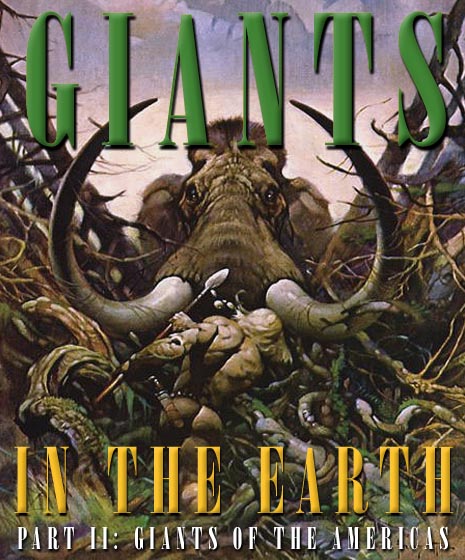
Editorial
|
Press Releases
|
Book Reviews
|
Fragments
Serpent Mound II
|
Giants II
|
Osiria II
Register
for our new Hall of Records Newsletter!
Questions? Comments? Suggestions? Advertising? Press Releases?
Contact us!
Part I: Giants of the ANE
|
Part III: Giants of Asia
|
Part IV: Giants of Europe
 NEW!
Giants of the Americas Discussion Board
NEW!
Giants of the Americas Discussion Board

(Requires Registration)
The Holocaust of Giants
|
Giant Characteristics
|
Giants of North America
Giants of Central & South America
|
Conclusions
|
Hunting for Giants
Giant Links
|
Giant Books
|
Audio
|
Video
|
Posters
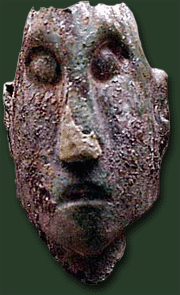
|
|
|
The face of a Hopewell Indian? This graven image is made of pure copper, and likely portrays a god or demigod of the Hopewell religion
— or perhaps a giant.
Image from
Ohio History Central.
|
|
 hough the
ancient Near East
is the place where most believe the giants of old originated, the Americas — particularly North America — also have a history rich with myths and legends of ancient giant inhabitants that had once dominated the fruited plain. Moreover, the Native American storytellers who tell tale of the exploits of these ancient men of renown believe that these gigantic, semi-divine beings were the original inhabitants of the Americas, having preceded modern Native Americans by many thousands of years.
hough the
ancient Near East
is the place where most believe the giants of old originated, the Americas — particularly North America — also have a history rich with myths and legends of ancient giant inhabitants that had once dominated the fruited plain. Moreover, the Native American storytellers who tell tale of the exploits of these ancient men of renown believe that these gigantic, semi-divine beings were the original inhabitants of the Americas, having preceded modern Native Americans by many thousands of years.
Modern Native Americans are, for the most part, genetically Asiatic in ancestry, and are believed by most mainstream scientists to have first appeared in the Americas around 9500 b.c. They had come to America, according to this theory, by
migrating across the Bering Strait,
and from there had proceeded to populate both American continents at a relatively rapid pace. In the process, they hunted down and destroyed the last of the gigantic mammals of the
Pleistocene epoch,
such as the woolly mammoth and the sabretooth tiger, and then proceeded to develop along typical uniformitarian lines. This is the theory that has been propounded by mainstream science and, until recently, it had proved to be generally sound.
However, more recent discoveries have forced more open-minded academics to reevaluate whether or not the Asiatic invaders had met and eliminated only gigantic mammals. Increasing evidence suggests that these "Paleo-Indians" also fought and defeated gigantic humans as well. New archaeological discoveries have forced academics to push their dates for human inhabitation of the Americas back literally tens of thousands of years. However, though these discoveries of common potsherds, clothing, and similar artifacts have been accepted into mainstream science, other discoveries, such as the discovery of numerous ancient giant skeletons — and even giant mummies — throughout the Americas, have been hushed up and quietly reburied, or relegated to the
vaults of the
Smithsonian
� la
Indiana Jones®. All evidence of these ancient giants of the Americas has been systematically hidden away from public view, and all those who attempt to tell about the true history of ancient America have been systematically attacked as frauds and charlatans. Yet, as we will see, much evidence of the ancient giants of the Americas still exists. It is now time for this "holocaust of giants" to be revealed.

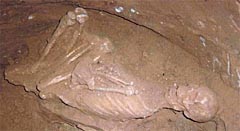
|
|
|
Possible giant skeleton found in the southeast. This particular skeleton was measured and found to be over 8-1/2 feet tall, though
this fact has not been verified as the location of this skeleton has not been revealed. Skeletons of this type have been reported all
over the United States, particularly in the southeast. Image from
Ancient American.
|
|
As English, German, Dutch,
Norwegian
and other European settlers moved west to settle the fruited plain, they came across countless
mound structures
that literally dotted the landscape. As they cleared the land for settlement and agriculture, they dug deep into these mysterious mounds and, more often than not, found that they were burial mounds for the ancient cultures that preceded them. Asking the remnant of the once numerous aboriginal inhabitants of the land whether or not they created these mounds, they were told that that many of them preceded the time of the "red man", some by a very long time. And these statements proved true as, though most mounds were indeed left behind by the ancestors of the Native Americans who greeted the pioneers, some of the most ancient contained the bones of a long extinct race of giants that the Native American remnant still recalled in their tribal traditions. The pioneers, unencumbered by "scientific" predispositions and hidden agendas, simply recorded the facts as they saw them — and what they wrote down was astonishing. As Ross Hamilton explains in his seminal article,
"Holocaust of Giants",
The first hint we had about the possible existence of an actual race of tall, strong, and intellectually sophisticated people, was in researching old township and county records. Many of these were quoting from old diaries and letters that were combined, for posterity, in the 1800s from diaries going back to the 1700s. Says
Vine
in this understanding: "Some of these old county and regional history books contain real gems because the people were not subjected to a rigid indoctrination about evolution and were astonished about what they found and honestly reported it."
The title pages of the early county and pioneer history books often included phrases like "CAREFULLY WRITTEN AND COMPILED" and "LEST WE FORGET."
Some time before archaeology came to subscribe the general public to its view of prehistory — generations prior to Darwin's troublesome theory — the pioneers thought that some of the earthworks were as ancient as could be concurrent with human habitation in America. Some among the early settlers exercised their pens assured that the earthworks were not built by the direct ancestry of the native people living in the historical period, but rather were constructed in a more remote era encompassing a different social order. They compared the "Mound Builders," with the "Indians," clearly discerning the former as belonging to an earlier time — possessing a different fate or destiny from the latter.1
These reports — which took place centuries before Darwinism and its baleful offspring poisoned the well of true scientific inquiry into the true history of humanity — seem unbelievable to readers today, "enlightened" as they are as to the party line view of history. The truth about America's ancient history, however, is somewhat different than the highly sanitized, politically correct view ladled out like so much gruel by academics today, as is evidenced only by a mere handful of historical reports from one area of the country alone — the Ohio Valley:
|
|
|
|
|

|
|
|
The title pages of the early county and pioneer history books often included phrases like "CAREFULLY WRITTEN AND COMPILED" and
"LEST WE FORGET", partly because some of the things written therein were so fantastic. Image and text adapted from
Serpent Mound Mysteries.
|
Evidence for the occupation of this region before the appearance of the red man and the white race is to be found in almost every part of [Marion] county, as well as through the northwest generally. In removing the gravel bluffs, which are numerous and deep, for the construction and repair of roads, and in excavating cellars, hundreds of human skeletons, some of them of giant form, have been found. A citizen of Marion County estimates that there were about as many human skeletons in the knolls of Marion County as there are white inhabitants at present!
— The History of Marion County, Ohio
Mastodonic remains are occasionally unearthed, and, from time to time, discoveries of the remains of Indian settlements are indicated by the appearance of gigantic skeletons, with the high cheek bones, powerful jaws and massive frames peculiar of the red man, who left these as the only record with which to form a clew to the history of past ages.
— The History of Brown County, Ohio
Three skeletons were found at the mouth of the Paw Paw Creek many years later, while Nim (Nimrod) Satterfield was justice of the peace. Jim Dean and some men were digging for a bridge foundation and found these bones at the lower end of the old buffalo wallow. She thought it was Dr. Kidwell, of Fairmont, who examined them and said they were very old, perhaps thousands of years old. She said that when the skeletons were exposed to the weather for a few days, their bones turned black and began to crumble, that Squire Satterfield had them buried in the Joliffe graveyard (Rivesville). All these skeletons, she said, were measured, and found to be about eight feet long.
— Now and Long Ago: A History of the Marion County Area 2
Throughout the eighteenth, nineteenth, and even the twentieth century, amateur excavators routinely found giant skeletons in mounds and caves from the upper northeast to the
southeast,
the
Midwest,
and scattered throughout North America. Discoveries of giant skeletons appear to have been concentrated around the Ohio Valley, however, the area that is now known for its numerous
mound structures.
The Ohio Valley,
as we have seen,
was the epicenter of Native American life for many thousands of years during the Archaic and Woodland periods of ancient American history. It was here, according to the original eyewitness accounts, that numerous giant skeletons and countless irreplaceable artifacts were discovered by intrepid settlers interested in discovering the true history of the New World. However, though many of these giant skeletons simply mouldered away into the soil days or even hours after they were exposed to the elements, many other giant skeletons, some with strands of blond or red hair still clinging tenaciously to their skulls, were covered up, spirited away or destroyed as part of an ongoing "holocaust" of America's true history.

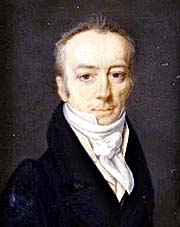
|
|
|
James Smithson, the man behind the institution. Image from
The Smithsonian.
|
|
The Smithsonian
was founded in 1836 by the bequest of one James Smithson, a wealthy English scientist who left a princely sum of $500,000 "to the United States of America, to found at Washington, under the name of the Smithsonian Institution, an establishment for the increase and diffusion of knowledge among men."3 Though the institution initially fulfilled Smithson's mandate, after a few decades of growth and sound management, creeping bureaucracy set in, and the museum's lofty goals began to outstrip its ability to properly manage its assets. Furthermore, the decision of one man, Smithsonian executive John Wesley Powell, set in motion a series of events that led to a historical and archaeological disaster of a magnitude so great that it is difficult to fully comprehend.
Powell had lived among the Native Americans, and had become sensitive to their plight. As a result, when the time came for the museum to organize its strategy for systematically analyzing and cataloging all of the information that was to be found in the New World, the decision was made to take an isolationist approach, rather than a cultural diffusionist approach. The isolationist approach posited that the ethnically Asiatic Native Americans that met Columbus and the Pilgrims were the same peoples who had populated the continent since the beginning of human history, and that there had been no other contact between them and any other non-Asiatic peoples whatsoever, period. However, though it appears that the Asiatics had indeed dominated the Americas for thousands of years, new evidence, previously suppressed, appears to show that there was indeed interaction with other cultures that had immigrated to the New World in prehistoric times. This approach, the "cultural diffusionist" approach, is the new paradigm in ancient historical studies, and helps explains the existence of giant, blond and red-headed skeletons throughout the Americas.
As a result of Powell's decision to reject any and all evidence that might contradict his prefabricated theory that early America had not been visited by any European, African, Middle-Eastern, or any other non-Asiatic, non-Native peoples, voluminous amounts of irreplaceable historical data were lost, miscategorized, or "misplaced". As Hamilton explains, "Armed with a self-created doctrine powered by ample funding, and with a little help later from the one-way door to the Smithsonian's inaccessible catacombs, the years that followed saw Powell and his underling nearly succeed in the obliteration of the last notions of the legendary, mysterious, and antique class of mound building people, and for that matter, any people that didn't fit into the mold of his theory. Did Powell intentionally overlook some of the archaeology so as to focus on his own special agenda?"4
This poor decision then led to a wholesale plunder of mounds, caves, and anything else Powell and his cronies could get their hands on. And in the process, anything that fit into their narrow paradigm of American history was kept, while everything that did not, met an
ignominious
end. So much devastation was wrought by this man's poor decision and concomitant mismanagement, overloading Smithsonian storage with an impossibly large amount of miscategorized artifacts, that even today the Smithsonian has not fully cataloged everything. Worse, as a result of this decision, our understanding of America's ancient history in general has been woefully inadequate at best, and at worst, just plain wrong. Powell and Co. likely did not purposely destroy data, though some of the precious evidence of America's gigantic past may have been lost or destroyed in transit. The real problem lay in the fact that these countless crates of precious truth are lost in the massive, almost legendary "Smithsonian Warehouse", guarded by both security guards and security by obscurity. And as the multiplicity of filing systems in use in the Smithsonian can best be described as
byzantine,
it is likely that they will stay there for some time. As Cooke explains,
Rumored to be beneath the Vatican lie many levels of secret, impregnable vaults that make up the legendary Vatican Archives. Supposedly containing the plunder of millennia and the secrets of the ages, their contents have filled the imaginations of countless generations. Perhaps not equal in quality, but certainly rivaling in quantity, are the archives of the Smithsonian Institution. And in those archives, open only to government officials, lie the bones of many thousands of corpses dug up, described and stored without study, many for over a century and a half. Scores, if not hundreds, of these skeletons are considered giants and yet, they lie deteriorating, not finding the slightest interest from anthropologists. Wanting no part in rocking the neatly defined, religiously correct American prehistory model, the researchers ignore them now and there is no sign this will ever change.
Hidden in dark, inaccessible storage is a sad example of scientific domination over social understanding and cultural history. Not to be found in the history books, the science references or the classroom is undeniable evidence that a race of giants had a prominent presence on the North
American continent. Also hidden from public understanding is the fact that giants were among the native people who fell before the colonial
|
|
|

|
|
|
The fabled "Smithsonian Warehouse", depicted at the end of
Raiders of the Lost Ark
wherein the Ark of the Covenant was stored until "top men" could analyze it. Though the actual location of the Lost Ark is most likely in
Axum, Ethiopia,
rumor has it that the warehouse does contain numerous giant skeletons and artifacts from countless plundered mounds and burial caves from all over the United States. Image from
IndyFan.com.
|
|
eradication crusade. Only the fortunate cultural conscience of amateur historians, writing about the prominent events of their individual communities, preserved easily accessible evidence of giants in our North American past.
Though there is much evidence in the written record of the Smithsonian it is an overwhelming and disorganized system typical of a rapid and misguided mass internment project.... All evidence, showing anything not fitting a Stone Age culture better eliminated than trifled with or indicating anything that might warrant serious study, was quietly filed away and warehoused in obscurity.5
Though most of the ancient tombs of the giants have been plundered and effectively lost, much historical data still exists regarding the existence of giants, due to the numerous written accounts left behind by our pioneer ancestors. These stories paint a picture of ancient America that is very different than that told in the standard history books. First, however, let us go over in detail the specific characteristics of the giants as evidenced by the North American finds, combine them with parallel references to
giants of the ancient Near East and related regions,
and then attempt to formulate a theory as to how they came to the Americas.

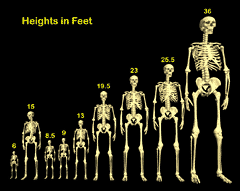
|
|
|
This chart represents the comparative sizes of giants throughout history from all over the world. Sizes of giants in various accounts range anywhere from 8-1/2 to 36 feet or more. Modern man is presented on the far left for comparison.
Image from Steve Quayle's
The Q Files.
|
|
Though we have some references to the physical characteristics of giants of the ancient Near East, such as their great size, strength, fearlessness in battle and usage of advanced weapons and armor, there is substantially more detailed evidence available regarding the physical appearance of American giants. This is due to the fact that, unlike the giants of the ancient Near East, giant skulls, giant skeletons, and even giant mummies reportedly have been found throughout the Americas, usually accompanied by a substantial amount of peculiar artifacts.
However, giants are more than just tall, powerful, beings. Their skeletal remains often show characteristics that are not only unique to the regions in which they lived, but also unique to their breed, unheard of in homo sapiens. More than just tall, powerful, manlike creatures, giants also displayed characteristics that ranged from the merely unusual to the truly bizarre.
|
|

|
|
|
Modern "giant"
Manute Bol
from
Sudan
is 7 feet, 7 inches tall and 240 pounds in his stocking feet. Bol could dunk the ball without jumping, but he was also physically strong
and a good all-around athlete. However, at 240 pounds Bol is much slimmer than the giants of old, who were proportionally broader and
heavier as well as taller, making Bol more likely a tall man rather than a true giant.
Image from
The Lair of Manute Bol.
|
 GREAT SIZE:
Giants of the Americas have ranged in size from a more common 7-9 feet tall all the way to massive tyrants standing as high as 12 feet tall or taller. Today's "giants" such as former NBA star
Manute Bol
are not the same as the giants of old, however, which were proportionally broader and heavier as well as taller.
GREAT SIZE:
Giants of the Americas have ranged in size from a more common 7-9 feet tall all the way to massive tyrants standing as high as 12 feet tall or taller. Today's "giants" such as former NBA star
Manute Bol
are not the same as the giants of old, however, which were proportionally broader and heavier as well as taller.
 GREAT STRENGTH:
Giants were more than proportionally strong. Though the average giant was perhaps 50% taller (9 feet tall vs. 6 feet tall) and probably at least 100% more massive (400 pounds vs. 200 pounds) than the typical homo sapiens, they were able to lift and carry many times more weight than normal men, perhaps 6 times as much (600%) or more. Whether it was because of the mechanical advantages they had due to their great size, or the fact that they appear to have been
genetically engineered
to be exceptionally strong, giants were exceptionally well suited to the rigors of combat as well as lifting heavy weights for building and other purposes. As such, it may explain how some of the huge
megalithic structures
around the world may have been built, whose existence cannot otherwise be explained.
GREAT STRENGTH:
Giants were more than proportionally strong. Though the average giant was perhaps 50% taller (9 feet tall vs. 6 feet tall) and probably at least 100% more massive (400 pounds vs. 200 pounds) than the typical homo sapiens, they were able to lift and carry many times more weight than normal men, perhaps 6 times as much (600%) or more. Whether it was because of the mechanical advantages they had due to their great size, or the fact that they appear to have been
genetically engineered
to be exceptionally strong, giants were exceptionally well suited to the rigors of combat as well as lifting heavy weights for building and other purposes. As such, it may explain how some of the huge
megalithic structures
around the world may have been built, whose existence cannot otherwise be explained.
 RED OR BLONDE HAIR:
The early pioneers often took pride in the fact that the tall, powerful giants they were uncovering in the various mounds that they were leveling for agricultural purposes actually had hair that was similar in color to their own: blonde, and occasionally red. These colors are unique to Europeans so, by their very existence, these blonde and
red-headed mummies
prove beyond a shadow of a doubt the cultural diffusion theory of American history.
Red-headed mummies
were purportedly also found in
Mammoth Cave,
but these have apparently been reburied and hidden until further notice.
Red haired mummies also reportedly have been found in
Lovelock Cave
near
Lovelock, Nevada
though, of course, no images are available as of yet. These and other discoveries no doubt highly motivated the Smithsonian's hatchet men to redouble their efforts to hide or destroy the evidence of America's true past.
RED OR BLONDE HAIR:
The early pioneers often took pride in the fact that the tall, powerful giants they were uncovering in the various mounds that they were leveling for agricultural purposes actually had hair that was similar in color to their own: blonde, and occasionally red. These colors are unique to Europeans so, by their very existence, these blonde and
red-headed mummies
prove beyond a shadow of a doubt the cultural diffusion theory of American history.
Red-headed mummies
were purportedly also found in
Mammoth Cave,
but these have apparently been reburied and hidden until further notice.
Red haired mummies also reportedly have been found in
Lovelock Cave
near
Lovelock, Nevada
though, of course, no images are available as of yet. These and other discoveries no doubt highly motivated the Smithsonian's hatchet men to redouble their efforts to hide or destroy the evidence of America's true past.
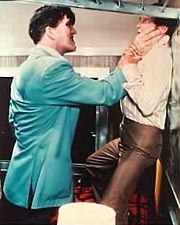
|
|
|
Seven-foot-two-inch, 350-pound actor
Richard Kiel
easily overpowering 007 as the assassin "Jaws" in
The Spy Who Loved Me. Despite his great size and strength, even Kiel would have been considered relatively small by comparison with most
ancient American giants.
Image from the
Official Richard Kiel Fan Club
|
|

|
|
|
Richard Kiel as a 9-foot-tall "Kanamit" alien from the Twilight Zone episode,
"To Serve Man".
Image from
JC's Place.
|
|
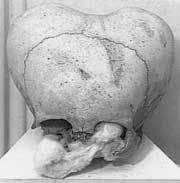
|
|
|
Giant skull from Peru with a shape very similar to that displayed by the Kanamit alien. Perhaps this skull or one like it was the
inspiration for the costume designer?
Image from
BUFO Radio.
It is interesting to note that in The Spy Who Loved Me, "Jaws" was a giant assassin with steel teeth that he used to kill his
victims. In "To
Serve Man", the Kanamit were a race of 9-foot-tall giant cannibals with domed, vaulted skulls. Unusual height, strength, teeth, skull shape,
cannibalism, and technological sophistication were all characteristics of the giants. More recently, they have also been associated with the
UFO phenomenon.
Click here
to see some video clips of Mr. Keil's great size and strength in action.
|
|
 FACIAL FEATURES:
Just as the hair color of the giants tends to be more European in color, so too the facial features of the giants tend to be European as well. High foreheads, high cheekbones, strong chins with prominent clefts, and possibly even a prominent gap between the two front teeth, facial features that all indicate that they were at least partly related to the Europeans. Most of the "shorter" giants in the 7-9 foot range tended to have more Native American features, as they were apparently the product of intermarriage between the original "European" type giants and the Asiatic natives, but the taller ones — especially the mummies — tended towards a more European-type physiognomy.
FACIAL FEATURES:
Just as the hair color of the giants tends to be more European in color, so too the facial features of the giants tend to be European as well. High foreheads, high cheekbones, strong chins with prominent clefts, and possibly even a prominent gap between the two front teeth, facial features that all indicate that they were at least partly related to the Europeans. Most of the "shorter" giants in the 7-9 foot range tended to have more Native American features, as they were apparently the product of intermarriage between the original "European" type giants and the Asiatic natives, but the taller ones — especially the mummies — tended towards a more European-type physiognomy.
 DOUBLE DENTITION:
One of the two features that truly set apart the giants as a specific subspecies of humanity — as opposed to being a variation on homo sapiens — are the frequent reports of "double dentition", or two sets of teeth, one behind the other. No one who has researched the subject is aware of why some tribes of giants had two sets of teeth. Some have speculated that it is an "all the better to eat you with" approach, where it gave them a better grip on their food, but no other land animals have this feature. Sharks do have multiple layers of teeth however, up to eight, but they are not permanent, instead constantly rotating forward to replace teeth that are frequently lost.6 Thus, the reasons for the extra set of teeth remain, to this point, unknown.
DOUBLE DENTITION:
One of the two features that truly set apart the giants as a specific subspecies of humanity — as opposed to being a variation on homo sapiens — are the frequent reports of "double dentition", or two sets of teeth, one behind the other. No one who has researched the subject is aware of why some tribes of giants had two sets of teeth. Some have speculated that it is an "all the better to eat you with" approach, where it gave them a better grip on their food, but no other land animals have this feature. Sharks do have multiple layers of teeth however, up to eight, but they are not permanent, instead constantly rotating forward to replace teeth that are frequently lost.6 Thus, the reasons for the extra set of teeth remain, to this point, unknown.
 SIX DIGITS:
Another attribute that is unique to the giants is the existence of an extra finger on each hand, and an extra toe on each foot, for a total of 6 digits per hand and foot, 24 in total. This has been seen not only in some American giant skeletons, but was also one of the traits some of the giants described in the Bible displayed. According to the Second Book of Samuel, an unnamed giant, a
Rephaim,
was described as having six fingers and six toes: "In still another battle, which took place at Gath, there was a huge man with six fingers on each hand and six toes on each foot-twenty-four in all. He also was descended from Rapha."
(
2 Sam. 21:20)
Interestingly, even today some children are born with an extra finger or toe, a condition known as
hexadactyly, lit., "six fingers".
SIX DIGITS:
Another attribute that is unique to the giants is the existence of an extra finger on each hand, and an extra toe on each foot, for a total of 6 digits per hand and foot, 24 in total. This has been seen not only in some American giant skeletons, but was also one of the traits some of the giants described in the Bible displayed. According to the Second Book of Samuel, an unnamed giant, a
Rephaim,
was described as having six fingers and six toes: "In still another battle, which took place at Gath, there was a huge man with six fingers on each hand and six toes on each foot-twenty-four in all. He also was descended from Rapha."
(
2 Sam. 21:20)
Interestingly, even today some children are born with an extra finger or toe, a condition known as
hexadactyly, lit., "six fingers".
|
|
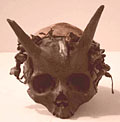
|
|
|
Horned human skull on display in "French Museum". Although unverified, the image is certainly compelling. Note the laurel leaves
added to the display in order to give it a sylvan,
"puckish" satyrical appearance.
|
|
|
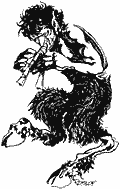
|
|
|
The greek demigod Pan. Pan was a
satyr,
a horned composite being with the upper body of a man and the lower body of a goat, usually associated with the night and the forest.
|
 HORNS:
Some rare specimens of giants are said to have horns protruding from their head like that of a goat or, more specifically, a satyr. As Sutherland explains, "Human skulls with horns were discovered in a burial mound at Sayre, Bradford County, Pennsylvania, in the 1880's. Horny projections extended two inches above the eye-brows, and the skeletons were seven feet tall, but other than that were anatomically normal. It was estimated that the bodies had been buried around A.D. 1200. The find was made by a reputable group of antiquarians, including the Pennsylvania state historian and dignitary of the Presbyterian Church (Dr. G.P. Donehoo) and two professors, A.B. Skinner, of the American Investigating Museum, and W. K. Morehead, of Phillips Academy, Andover, Massachusetts. The bones were sent to the American Investigating Museum in Philadelphia, where they were later claimed to have been stolen and have never been seen again."7
HORNS:
Some rare specimens of giants are said to have horns protruding from their head like that of a goat or, more specifically, a satyr. As Sutherland explains, "Human skulls with horns were discovered in a burial mound at Sayre, Bradford County, Pennsylvania, in the 1880's. Horny projections extended two inches above the eye-brows, and the skeletons were seven feet tall, but other than that were anatomically normal. It was estimated that the bodies had been buried around A.D. 1200. The find was made by a reputable group of antiquarians, including the Pennsylvania state historian and dignitary of the Presbyterian Church (Dr. G.P. Donehoo) and two professors, A.B. Skinner, of the American Investigating Museum, and W. K. Morehead, of Phillips Academy, Andover, Massachusetts. The bones were sent to the American Investigating Museum in Philadelphia, where they were later claimed to have been stolen and have never been seen again."7
"Horned" giants would indicate a genetic mixing between man and animal, as had been intimated by
Edgar Cayce
and
others.
Cayce believed that man had been created by spiritual beings "projecting" themselves into physical matter, with results that were part human, part animal. Others further clarify that these spiritual beings, also known as "fallen angels", had disrupted the natural order by artificially mixing the genes of men and animals in order to create breeds of mankind that had advantages over the others, such as height, strength, intelligence, and so forth. In the process, however, side effects occurred, such as, for example, horns. This may have given rise to the story of
satyrs
and other animal-human hybrids often mentioned in the myths and legends of peoples around the world, genetic traits that occasionally manifest themselves in the blended human genome.
|
|
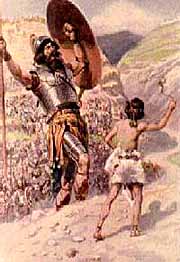
|
|
Goliath's kit included bronze weapons and armor, bronze being copper alloyed with tin, zinc and phosphorus. Goliath's weapons and
armor were likely more advanced than that of anyone else on the field. His relatives
also apparently had superior weapons as well, perhaps made of iron or even steel.
|
 ADVANCED WEAPONRY:
Some giant skeletons have been found with relatively advanced weaponry of a type otherwise unheard of in the Americas. Swords, shields, armor, helmets, and related weaponry more like European and ancient Near Eastern armor types than anything found in the Americas. As Quayle explains,
"Nature, in its December 17, 1891, issue, reported that at a depth of fourteen feet in a large
Ohio burial mound
excavators found the skeleton of a massive man in copper armor. He wore a copper cap, while copper moldings encased his jaws. Copper armor also protected his arms, chest, and stomach. A necklace made of bear's teeth and inlaid with pearls decorated his neck. At his side lay the skeleton of a woman, probably his wife."8
Goliath
and his kin were also said to wear advanced armor and had swords that were described as "new", which might be better translated as "advanced", possibly meaning that they were made of bronze, iron or even steel. Advanced weapons and armor appear to be yet another trademark of the giants.
ADVANCED WEAPONRY:
Some giant skeletons have been found with relatively advanced weaponry of a type otherwise unheard of in the Americas. Swords, shields, armor, helmets, and related weaponry more like European and ancient Near Eastern armor types than anything found in the Americas. As Quayle explains,
"Nature, in its December 17, 1891, issue, reported that at a depth of fourteen feet in a large
Ohio burial mound
excavators found the skeleton of a massive man in copper armor. He wore a copper cap, while copper moldings encased his jaws. Copper armor also protected his arms, chest, and stomach. A necklace made of bear's teeth and inlaid with pearls decorated his neck. At his side lay the skeleton of a woman, probably his wife."8
Goliath
and his kin were also said to wear advanced armor and had swords that were described as "new", which might be better translated as "advanced", possibly meaning that they were made of bronze, iron or even steel. Advanced weapons and armor appear to be yet another trademark of the giants.
 CANNIBALISM:
Native Americans legends usually described the giants as having been cannibals, though there apparently were some "good" giants that had given up eating human flesh. As Dieterle explains "Like other spirits, the Man Eaters can be divided into two tribes: the Good Giants and the Bad Giants. Most seem to have belonged to the tribe of Bad Giants who indulge their appetite for human flesh, but the Good Giants have belied their name by abandoning the practice of eating people."9 For the bad giants, however, humans were their favorite food, and they would go out of their way to acquire them. "Human beings were the favorite food of the Bad Giants who would go to some lengths to get it. On occasions they massacred whole villages in order to eat the inhabitants. Like other man eaters, such as the
Bad Thunderbirds10
they would let some people live just to fatten them up so that they would be all the tastier later. Good, fat humans, apparently make excellent soup as well. When the Giants wanted to "eat soup," as they put it, one way to get it was to challenge the humans to games of chance.11
This story is not unlike the Greek story of the
Riddle of the Sphinx,
wherein a female sphinx would waylay travelers and, if they could not answer her riddle, she would eat them. Similarly, if the giants won the game of chance, or perhaps answered a riddle in a
riddle game,
they could eat the humans.
Cannibalism practiced by ancient Near Eastern giants was also implied when the spies who were sent to spy out Canaan in preparation for the Conquest came back with the warning that "The land we explored devours those living in it."
(Num.
13:32)
Most commentators believe that this was a cryptic reference to the cannibalism practiced by the giants.
Interestingly, studies have shown that giant cannibal fish often appear within fish populations when the larger fish need to offset the advantage that smaller fish have over them in the areas of foraging and efficient use of energy in order to survive. The larger fish offset the superior capabilites of the smaller fish by eating them, thus preserving themselves
at the expense of
effective, useful forms of life that fit in well with their environment.12
CANNIBALISM:
Native Americans legends usually described the giants as having been cannibals, though there apparently were some "good" giants that had given up eating human flesh. As Dieterle explains "Like other spirits, the Man Eaters can be divided into two tribes: the Good Giants and the Bad Giants. Most seem to have belonged to the tribe of Bad Giants who indulge their appetite for human flesh, but the Good Giants have belied their name by abandoning the practice of eating people."9 For the bad giants, however, humans were their favorite food, and they would go out of their way to acquire them. "Human beings were the favorite food of the Bad Giants who would go to some lengths to get it. On occasions they massacred whole villages in order to eat the inhabitants. Like other man eaters, such as the
Bad Thunderbirds10
they would let some people live just to fatten them up so that they would be all the tastier later. Good, fat humans, apparently make excellent soup as well. When the Giants wanted to "eat soup," as they put it, one way to get it was to challenge the humans to games of chance.11
This story is not unlike the Greek story of the
Riddle of the Sphinx,
wherein a female sphinx would waylay travelers and, if they could not answer her riddle, she would eat them. Similarly, if the giants won the game of chance, or perhaps answered a riddle in a
riddle game,
they could eat the humans.
Cannibalism practiced by ancient Near Eastern giants was also implied when the spies who were sent to spy out Canaan in preparation for the Conquest came back with the warning that "The land we explored devours those living in it."
(Num.
13:32)
Most commentators believe that this was a cryptic reference to the cannibalism practiced by the giants.
Interestingly, studies have shown that giant cannibal fish often appear within fish populations when the larger fish need to offset the advantage that smaller fish have over them in the areas of foraging and efficient use of energy in order to survive. The larger fish offset the superior capabilites of the smaller fish by eating them, thus preserving themselves
at the expense of
effective, useful forms of life that fit in well with their environment.12
 DEAFENING ROAR:
Steve Quayle
has pointed out on an interview he did on
Coast to Coast A.M.
that the giants tended to yell when they talked, rather than speaking normally, as we understand it. When they were aroused, they emitted a deafening roar which was terrifying to all who were not used to it. Quayle believes this to be true based upon the structure of the nasal passages on some of the giant skulls, as well as historical reports of their terrifying cries.13
DEAFENING ROAR:
Steve Quayle
has pointed out on an interview he did on
Coast to Coast A.M.
that the giants tended to yell when they talked, rather than speaking normally, as we understand it. When they were aroused, they emitted a deafening roar which was terrifying to all who were not used to it. Quayle believes this to be true based upon the structure of the nasal passages on some of the giant skulls, as well as historical reports of their terrifying cries.13

|
|

|
|
|
American eugenicist Dr. Otmar Freiherr von Verschuer examines twins. His assistant, one
Josef Mengele
— who would later become known as the infamous Nazi "Angel of Death" — continued these experiments at Auschwitz. The Nazi obsession with twins must have had some sort of very important meaning, judging from the emphasis placed upon them. Image from
JTA - Global News Service of the Jewish People.
|
Many have speculated on why the giants had such strange characteristics as six fingers and double sets of teeth, though no one as of yet has come up with a satisfactory answer. However, the answer may lie in the horrid genetic experiments of the Third Reich, in which
twins
figured prominently. Hitler was obsessed with the eugenics idea (that had actually originated in the United States around the turn of the century), the goal of which was to eliminate everyone on Earth that was not "Nordic", i.e., blond-haired, blue eyed, tall and intelligent — in other words, like the giants. "The world thought Hitler was mad and barely understood his rationales. But the concept of a white, blond-haired, blue-eyed master Nordic race was not Adolf Hitler�s. The idea was created in the United States at least two decades before Hitler came to power."14
Dr. Otmar Freiherr von Verschuer was a pioneer in the American eugenics movement, and his prodigy, one
Joseph Mengele,
carried on his horrid experiments at
Auschwitz
focusing, strangely enough, on
twins.
Black explains,
At the time of
Rockefeller�s
endowment, Otmar Freiherr von Verschuer, a hero in American eugenics circles, functioned as a head of the Institute for Anthropology, Human Heredity and Eugenics.
Rockefeller funding
of the Institute for Anthropology continued directly and through other research conduits
during Verschuer�s early tenure.
In 1935, Verschuer left the Institute to form a rival eugenic facility in Frankfurt that was much heralded in the American eugenic press.
Research on twins in the Third Reich exploded, backed up by government decrees mobilizing all twins. At about that time, Verschuer wrote in Der Erbarzt, a eugenic doctors� journal he edited, that Germany�s war would yield a
�total solution
to the Jewish problem.�
Verschuer had a long-time assistant. His name was Josef Mengele.
On May 30, 1943, Mengele arrived at Auschwitz. Verschuer notified the German Research Society, �My assistant, Dr. Josef Mengele (M.D., Ph.D.) joined me in this branch of research. He is presently employed as Hauptsturmfuhrer [captain] and camp physician in the Auschwitz concentration camp. Anthropological testing of the most diverse racial groups in this concentration camp is being carried out with permission of the SS Reichsfuhrer
[Heinrich Himmler].�
Mengele began searching boxcars that arrived at the camp for twins. When he found them, he performed beastly experiments, scrupulously wrote up the reports and sent the paperwork back to Verschuer�s institute for evaluation.15
Mengele is one of the most infamous of all the Nazis, having earned the nickname
"The Angel of Death"
at Auschwitz as he had been the selector who had decided who lived and who died. Although he is now considered to be one of history's greatest monsters, before his actions in the war he was considered to be an intelligent, well-educated man from a well-to-do family, who studied physical anthropology and genetics in college. He ended up working with von Verschuer at the Frankfurt University Institute of Hereditary Biology and Racial Hygiene. His research focused on the shape of the front of the jaw and how it varied amongst racial groups, and also
cleft palates,
a congenital birth defect where the skull is slightly divided at the roof of the mouth, leaving a gap, or "cleft". From there he proceeded to focus obsessively on twins, apparently in the context of trying to understand the bipolar nature of the development of the human body — specifically, how the two halves of the human skull fuse together. Unfortunately, the times brought out the true wicked character of the man, and he decided that the situation at Auschwitz was ideal for experimentation on twins. One twin who survived the ordeal recalls the experience:
Of all the aspects of Mengele�s character which are of interest, his research on twins is the focus of the
C.A.N.D.L.E.S.
organization. Beginning in 1944, twins were selected and placed in special barracks.... It is believed that Mengele had worked with twins under Verschuer at the University of Frankfurt. Auschwitz offered Mengele unlimited number of specimens where twins could be studied at random. According to Dr. Miklos Nyiszli in
Auschwitz: A Doctor's Eyewitness Account,
twins provided the perfect experimental specimens. One could serve as a control while the other endured the experiments. It was well known in the camp that when a twin went to the infirmary, (s)he never returned and that the other twin disappeared too....
Twins in the experiments describe three days of what must have been psychological examination and three days of laboratory experiments. "Three times a week we were marched to Auschwitz to a big brick building, sort of like a big gymnasium. They would keep us there for about six or eight hours at a time — most of the days..... We would have to sit naked in the large room where we first entered, and people in white jackets would observe us and write down notes. They also would study every part of our bodies. They would photograph, measure our heads and arms and bodies, and compare the measurements of one twin to another. The process seemed to go on and on."
The laboratory experiments were described by Kor as follows: "Most of the time, they would take blood from one arm, and they gave us shots in the other."
Experiments did not end with the death of the twins. Dissection of the corpses for final medical analysis is well documented by Nyiszli and by Lifton.
16
|
|

|
|
|
The skeleton of a type of conjoined twin known as
"Dicephalus",
where both heads of the twin share one body. Could the giants have
been the result of a "perfected" fusion of twins into one much larger "giant" individual? This would explain the extra set of teeth and
additional digits on hands and feet as imperfections of the process, and may also explain the occasional refences in folktales to two-
headed giants.
Image from
ConjoinedTwins.com. Warning: Not for the squeamish.
|
|
|
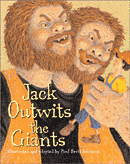
|
|
|
The villain in the classic tale of "Jack and the Beanstalk" is in fact a two-headed giant. Not only is it a two-headed giant,
it is also a red-headed, vicious cannibal. Coincidence? Unlikely.
Image from
Jack Outwits the Giants.
|
The Nazis believe that they had descended from giant, "Aryan supermen" that once lived in Germany and elsewhere but had been "polluted" by intermarriage with other, "lower" races that resulted in the loss of their great height, strength and
"magical powers".
To regain this former "genetic purity", and the commensurate height, strength and powers that had been lost, the Nazis actively sought out German and other European men and women who had the desirable, "Aryan" characteristics — blonde hair, blue eyes, good looks and tall, strong, athletic bodies — and created what were essentially state-sponsored brothels called
Lebensborn
that they were using in an attempt to breed a new group of giant "Aryan supermen" that essentially would be property of the state. They even went as far as to kidnap children who had these characteristics from families living in other countries such as Poland and Czechoslavakia and give them to German families for adoption, though these children also remained the property of the state. But there was even more method to the madness. Mengele was not just obsessed with Aryan purity, but even more so with the concept of twins. But how do twins fit into the genetic equation? Why obsessively test and measure
twins,
people with harelips, and how chin sizes and shapes vary from culture to culture, when you can restore your "genetic purity" merely through selective-breeding programs?
It appears that selective breeding was only the beginning of Hitler's mad quest to restore the so-called "Aryan race" to its former glory.
Though it seems wildly implausible, even impossible, the equation that involves the obsessive study of twins, the shape and division of the skull, the existence of giant humanoids in mankind's past who had six digits and two sets of teeth, and the theory that the Germans had descended from this "master race" of giants, can have only one answer: Mengele (and others) believed that the secret of the giants was that they had been created in ancient times by a
scientifically advanced race
who had successfully manipulated fertilized human eggs so as to produce the successful fusion of identical twins into one body — creating, in effect, one single "giant" individual that would, theoretically, grow to twice the size of an ordinary individual. This neatly explains many of the characteristics of the giants, including their great size, strength, and especially the double dentition and the extra fingers and toes, which would (and do) naturally occur as part of the process of twins becoming conjoined. It would also result in the bones, and particularly the skulls, becoming unusually strong and thick, which also corroborates well with those few skeletal remains of giants that have been found intact.
Moreover, if the process is indeed additive (or even possible), then multiple fused embryos might result in multiples of size, fused sextuplets perhaps being the means by which the rumored 36-foot giants (6 x 6) had been created. This "scientifically advanced race" may have also tinkered with the body's growth hormones, where it may have been that the sky was literally the limit for how tall they could make the giants. Larger brain capacity may have also resulted in increased intelligence, but apparently this increase in capabilities came at a cost — psychosis. Cannibalism and the other wicked behaviors known to have been displayed by giants can then be understood as the predictably psychotic behaviors of what were essentially natural-born
bipolar schizophrenics — two brains fused into one. As a result, they hated everyone and everything, and hated themselves above all. The net effect of this state of affairs was that, in order to survive psychologically, they were forced to focus their self-hatred outwards towards others. As a result of this need to turn their internal conflicts outward in order to remain at least marginally sane, the culture of the giants, and their religion, became one that was entirely based on war and domination of others. The alternative was that, if they did not make war on others outside of their group, they would then attack and kill each other, and then finally — with no one else left to kill — kill themselves. Thus, not only were the giants bred for war and conquest, they literally could not survive without it.
If this "fused-twins" scenario is indeed true, then it would appear that either mankind had at one time reached a high level of technological sophistication, or some sort of higher power had interfered with humanity some time in the past, tinkering with the
human genome
and reproductive process in order to create a breed of giant man that best suited their needs. It is our thesis, as elucidated in
Giants in the Earth Part I,
that it was the latter, though no doubt these "higher powers" also gave technology to mankind so that they could help these powers in achieving their goals. And what were these goals? As we saw in Part I, they were apparently world domination through the extermination of God's own homo sapiens in favor of a "superior" form of man — a "master race" of giants.

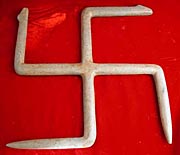
|
|
|
"Hopewell Green Slate Ceremonial Swastika". The
swastika
is an ancient symbol that, like the giants, can be found all over the world. This
Hopewell
version implies that the Hopewell may have also considered themselves to be a master race, the aristocracy of the Hopewell possibly
even being Aryan in descent. Note that the swastika is actually made up of two crossed
serpents.
Image from
The Barakat Gallery.
|
|
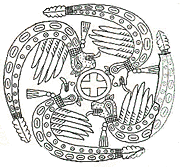
|
|
|
This engraved image from Spiro Mound in Oklahoma also shows a form of the swastika. Also known as the
sun wheel,
this swastika elaborates upon the
Native American concept
of the four directions and the four winds, under the "square sky" through
which the sun traveled.
Image from
InnerX.
|
|

|
|
|
A Mission Indian basket decorated with swastikas. This controversial symbol may have started its career in the Americas as a symbol of
an aggressive, warlike
invader race, but it has long since been changed by the Native Americans into a symbol of positive energy and natural cycles. It was
Hitler' purposeful misuse
of the symbol that led to its current stigma.
Image from
CaliforniaBaskets.com.
|
|
As we saw in
Part I,
the giants, or
"Nephilim"
were created by the fallen angels in the ancient times before the Flood — and possibly even before Adam — as a "vehicle" through which they could interact with the world. These giant, "artificial" forms of mankind were then used in an attempt to wipe out God's version of man, whom we now know as homo sapiens, but
God intervened
and wiped out the giants in a Flood before they could complete the job. However, the giants were recreated again after the Flood in the form of the
"Rephaim"
(lit., "those who were reborn")
in a second attempt to destroy homo sapiens and take over the world, an attempt that was delayed by the
Elamites,
and finally destroyed by the
Israelite invasion
of Canaan.
The Bible is thus a primary reference on how the giants came into being, as well as giving some details as to their behavior and appearance. However, the narrative in the Bible is limited to the ancient Near East, information on peoples living outside of that region being sketchy at best. Thus, for information on giants outside the ancient Near East, such as those that have been found in the Americas, we will need to turn to alternative sources, using the biblical references to giants as a guideline.

The Nazis were obsessed with the idea that they were the descendants of the
"Aryans",
a racial designation that has been applied to the peoples of Iran and northern India for thousands of years. The Nazis (and others) believed that Germany was the original home of the so-called
"Aryan race",
a "master race" that had migrated and conquered their way throughout the ancient world, forming elite classes, or "royalties", that have ruled over other peoples throughout the world ever since. This is known to have taken place in ancient Persia (Iran) under the
Achaemenids,
who ruled Persia and its large empire from approximately 560-330 b.c. The
Vedic Indians, the upper caste in Indian society, were also believed by some to come from a homeland in the northwest,
invading
India (and other places) and taking rule over the local inhabitants, a pattern of conquest and continuing dominion that perhaps led to the term "Aryan" taking on the concept of "Noble" or "master race".
Aryan is the Anglicization of the Sanskrit, Avestan and Vedic term arya. The literal meaning of the word is "Noble". Etymologically, it seems originally to denote kinfolk or clansmen, and later to be a general term of respect. The
Rigveda
describes people following the
Vedic
way to be Aryan. New archaeological findings suggest that the Aryans have been in India since at least the fourth millennium BC. Archeological records show that early in the 2nd millennium BC, ancient Persians (in present-day Iran) used the term Aryan to describe their lineage and their language. Darius the Great, King of Persia (521 - 486 BC), in an inscription in Naqsh-e-Rostam (near Shiraz in present-day Iran), proclaims: "I am Darius the great King.... A Persian, son of a Persian, an Aryan, having Aryan lineage...".
The term has become a term of art in the Zoroastrian, Buddhist, and Jain, and Hindu religions.
The Aryan tribes in the Indian subcontinent called their land Aaryaa varta or Aryan expanse/Aryan land. When the ancient Persians lived in the Inner Asian Steppes and moved south into today's Iran (the name itself derives from arya), they named the place Airyanem Vaejah, or The Iranian Expanse, and today the word survives as Iran. Many present day Iranian boy and girl names reflect this ancient relation: names like
Aryana,
Iran-dokht (Aryan Daughter), Arayn, Aryan-Pur, Aryaramne....
In fact, the root word *ar- or *arya- is one of the most widely distributed names of people and places in the Indo-European world. It gave a name not only to the Aryans of India, but also to the aristocrats, the aristoi, the "most noble," of Greece, and the Irish of �ire. Another grade of the root appears in Latin
ordo,
meaning "order." The original meaning of the word probably suggested a union, league, or confederacy.17

|
|
|

|
|
|
The swastika flag of the German Nationalsozialistische Deutsche Arbeiterpartei, or "National Socialist German Workers' Party",
"Nazi" for short. The swastika was first coopted by the Nazis in 1920, who called it the hakenkreuz, or "hooked cross".
Unlike the traditional swastika, the Nazi swastika is almost invariably depicted at 45� to the horizontal.
Image from
NationMaster.com.
|
|
Perhaps the strongest evidence of Aryan influence can be found by studying the religions of those countries which it is believed were either conquered or strongly influenced by invading Aryan tribes. The religion of the Aryans shared not only a common pantheon of gods, but also very similar symbology, the most common of which was the sun wheel, also known as the
swastika.
This symbol is nearly universal, being found both in the
ancient Near East,
Asia,
throughout
Europe,
and even in
the Americas.
As Boxer explains,
Before the Nazi Party adopted the swastika and turned it into the most potent icon of racial hatred, it traveled the world as a good luck symbol. It was known in France, Germany, Britain, Scandinavia, China, Japan, India and the United States.
Buddha's footprints were said to be swastikas. Navajo blankets were woven with swastikas. Synagogues in North Africa, Palestine and Hartford, Conn., were built with swastika mosaics.
The swastika gets its name from the Sanskrit word svastika, meaning well-being and good fortune. The earliest known swastikas date from 2500 or 3000 B.C. in India and Central Asia. A 1933 study suggests the swastika migrated from India across Persia and Asia Minor to Greece, then to Italy and Germany, probably in the first millennium B.C.18
|
|

|
|
|
The Nazis saw the tank as a modern upgrade to the chariot that, like the chariots of old, allowed them to quickly and easily defeat
and control large numbers of people. The
Amorites
of Canaan used the same methods, being reknowned for their skill in chariotry.
Image from
Calvin College: German Propaganda Archive.
|
The swastika, until Hitler coopted it for use as the
Nazi party
symbol, had been a relatively benign symbol of good fortune throughout the world, specifically symbolizing
the sun,
the four directions, and the four winds. However, like Hitler, it may be that the ancient Aryans also used it as a symbol of evil, in a reversed form that implied destruction instead of creation, of domination instead of cooperation. The ancient Aryans, like their Nazi descendants, were also a people bent on conquest and destruction. Moreover they, like the
Amorites
of ancient Canaan, were semi-nomadic in lifestyle, and rode
chariots
into battle, having the same methods of rapid, blitzkrieg-style warfare that the German armies also would use in their updated version of the chariot — the tank. The ancient Aryans also worshiped warrior gods that were very similar to the gods of the
Norse myths,
a fact that had helped convince Hitler and others that the northern Europeans were in fact descendants of the Aryans.
Interestingly, the Aryan gods were also very similar to the
gods of the
Amorites,
particularly,
Ba'al.
This evidence gave rise to the search for the original Aryan homeland, and thus, it was believed, to the origins of the European "race". Many scholars argued that the Aryans originated in the Inner Asian Steppes, from which they migrated both west into Europe and south into Afghanistan, Iran and parts of India around 1800 BC. The spread of the Aryans was supposed to explain how it came to pass that Indo-European languages became so widespread throughout Europe and Asia. It was thought, moreover, that the Aryans came as conquerors, displacing earlier peoples, in most of the places where the languages were spoken. They were able to conquer so much territory because their nomadic lifestyle, their use of the horse and wheeled vehicles such as chariots gave them a drastic military advantage.19

When people familiar with sci-fi/fantasy films hear the name "the Kurgan", they think of the villain from the popular cult classic film,
Highlander.
However, though the character of the Kurgan is fictional,
the Kurgan race
from which the character was drawn was not. The Kurgans were a real people who lived in the
steppes of Russia
between 5000-2000 b.c., thereafter apparently migrating from that region to settle practically every part of the world.
The Kurgan are believed by some to be the prototypical Indo-European or "Aryan" race, conquering as far east as Mongolia, as far west as Britain, as far north as Russia, and as far south as southern
Canaan.
Evidence suggests that they may have also made it as far as the South Pacific, and even to the Americas.
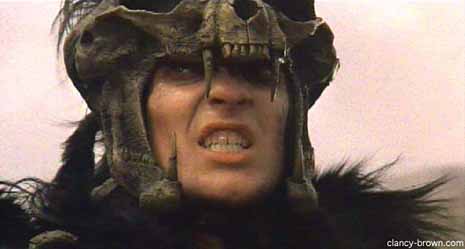
|
|
"The Kurgan" from the movie,
Highlander.
In the film, The Kurgans were correctly portrayed as an ancient, barbaric people from the steppes of Russia who, for amusement, had
tossed children into pits with hungry dogs to fight for meat. Ramirez, one of the other "immortals" in the film, described the giant
"Kurgan" character as such:
"He is the perfect warrior. He cares about nothing or no-one. He is completely evil."
Image from
Highlander
|
The Kurgan were a very ancient people, who had been around for thousands of years by the time of the Israelite invasion (ca. 1200 b.c.). The Kurgan, and the Indo-Aryans in general, were a warlike, semi-nomadic race that, according to the
Aryan Invasion
theory had, around 2000 b.c. and afterwards, begun to aggressively expand outwards from their base in central Asia. As a result, fragments of their religion, language and culture can be found all over the world.
The Kurgan people were an Indo-European culture existing during the fifth, fourth, and third millennia b.c.; they lived in northern Europe, from Russia across Germany, and various authorities have mounted a case for them being THE proto-Indo-European culture, from which all Indo-European cultures descend. Other researchers think it likely that later-day Kurgans were the "Sea People" who laid waste to the Holy Land around 1200 b.c. — traveling south along the Mediterranean in ships, with their women following them in wagons along the shore. The word kurgan means barrow or grave in Slavic and Turkic; Kurgan culture is characterized by pit-graves or barrows, a particular method of burial. They are also called the Pit-grave people, or Barrow people.
The earliest Kurgan sites are in the Ukraine and southern Russia, from which they spread by about 2000 b.c. to Europe, crossing the Dnieper River. Wherever Kurgan culture spread, it was marked by common elements unlike those of the surrounding Bronze-Age cultures.20

|
|
|
The
"Aryan Invasion"
theory illustrated. Based on archaeological, cultural and philological evidence, this theory posits that the Kurgans and other Indo-European "Aryan" peoples had at one time invaded Europe, Asia and the Middle East, bringing their language, religion and culture with them. The Caucusus, the region from which the Indo-European Kurgans emerged, is located at the center right of the image, between the Black and
Caspian Seas. Note also the southern invasion route took the Kurgan to southern and western
Canaan
at the same time the "giants" began
to become numerous in the region (around 2000 b.c. and afterwards).
Image from
Archaeology and Language : The Puzzle of Indo-European Origins.
|
|
The Kurgans were quite literally the original Caucasians, having originated from the area around the
Caucasus
from which the term has derived. They were tall, blonde-haired, and blue-eyed, expert horsemen and chariot riders, and buried their dead in large burial mounds, or "barrows". The term
kurgan,
in fact, means "burial mound". Interestingly, the early Kurgans appear to have coexisted with another, more primitive culture, generally referred to as
"Cro-Magnon".
As Elst explains,
The start of the Kurgan culture was accompanied by a change in the racial composition of the population of South Russia in about 4500 b.c.: The Dniepr-Donets people are known to be massive
Cro-Magnons,
continuous from the Upper Palaeolithic; the Strednij Stog-2 men are described as more gracile, tall-statured, dolichocephalic with narrow faces.... The skeletal remains are dolichomesocranial, taller-statured and of a more gracile type than those of their predecessors in the substratum. But the two racial types coexisted for long, though still culturally distinct. Kurgan II, ca. 4000-3500 b.c. Materials from this period demonstrate continuous coexistence with the Dniepr-Donets culture: two different physical types (both of "Cro-Magnon C" type, but with the Kurgan people being more gracile) and burial customs (collective burials in trenchlike pits characteristic of the Dniepr-Donets culture, and single burials of Kurgan type) were proved to be present even in the same villages.21
|
|
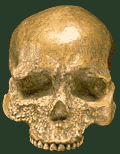
|
|
|
The very first "Cro-Magnon" skull to be discovered, found in Dordongne, France. Cro-Magnon was similar to but different than
homo sapiens,
displaying a more rounded skull. However, Cro-Magnon tended to be more massive, and may have accounted for some of the reports of
"giants" mentioned in traditions around the world.
Image from
Human Evolution at the Smithsonian Institution.
|
Cro-magnon
were unlike homo neanderthalis, actually being a form of human that were very similar in skeletal structure to homo sapiens, yet different. One of these differences, as Elst points out, is their massive size, both in height and strength. Though no "giant" specimens of cro-magnon are known to exist (or have been hidden or destroyed), it may be that remnants of Cro-Magnon man might account for the description of "giants" in the Earth that have been described all over the world. Moreover, the fact that they coexisted with the more gracile Kurgan for thousands of years, and the fact that the Amorites were also a mixture of both relatively tall and giant peoples, forms another potential link between the Aryans and the Amorites.
The fact that the Kurgan are equated by some with the pelishtim, or "sea-peoples" who invaded Canaan around 1200 b.c. is also interesting, as that is around the same time that Israel had conquered the Amorites and the remnant of the Rephaim in that region. The sea
peoples occasionally invaded from the sea for the next couple of centuries, up to the time of David (1000 b.c.), the time when
Goliath
made his appearance on the scene — Gath, his hometown, being on the Mediterranean sea coast. The remnant of the giants that David and his men faced also lived on the sea coast around that time, which creates a strong link between the invading Kurgan and the giants of the Bible. The appearance of burial mounds, or "barrows" in Palestine linked to the Kurgans/Amorites is another interesting link, as the very name "Kurgan" means, literally, "hill" or "burial mound".
For a variety of reasons, then, it would appear that the Kurgans were the same people as the
"Amorites",
those people that had been driven from Canaan by the Israelites during the time of Moses (ca. 1200 b.c.). Their religion, culture, style of warfare, area of control and the period during which they controlled it all correspond closely to the description of the Amorites — so closely, in fact, that it appears clear that they were actually one and the same. Also, as we saw in
Part I,
the Amorites were essentially a race of tall, warlike men, hybrid giants to be more precise, who were ruled over by a hierarchy of giant Rephaim who rode chariots — just like the Kurgan.
Og,
king of Bashan, one of the two remaining Rephaim rules of the Amorites by the time of the Conquest, was at least twelve feet tall — at least three feet taller than the tallest Amorite who probably averaged between 7-9 feet tall. This would explain why Mengele and the Nazis were simultaneously initiating two different programs of "racial hygiene" to recreate the ancient "Aryan" order: the first program, the "selective breeding" program, was designed to (re)create a race of seven- to nine-foot-tall, powerful
Gibborim-type
warriors that would serve as the footsoldiers for the Nazi armies, whereas the second, "twins" program was designed to create an "overlord" race of 12-foot-tall (or more)
Rephaim-type
giants that would serve as their commanders — exactly how it was in Canaan before the Israelite invasion, and in the world before the Flood. As such, it appears that the Israelites destroyed the Aryan/Amorite "master race" breeding program just in time, a task that the invading Allied armies of World War II may have also accomplished by defeating Nazi Germany.
To this point we have theorized that the Indo-Aryan "Kurgan" were the same as the "Amorites" mentioned in the Bible. Moreover, we have theorized that the exceptionally tall giants such as Og mentioned in the Bible may have been giant Cro-Magnon remnants that lived among the Kurgans, a form of human that we had theorized in Part I might have been specially bred by fallen angels to be even larger and stronger than the giant Amorites. We have also determined that the Kurgans were an aggressive, warlike race that had invaded as far west as Ireland, and as far East as China, possibly even as far east (and south) as New Zealand. The question remains, however, did the Kurgans make it as far as the Americas? Let us look at the characteristics of the Kurgans and see if there any points of commonality between the giant Kurgans and the giants of the Americas:
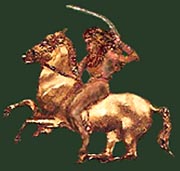
|
|
|
A Kurgan horseman. The Kurgan were master horsemen, a skill that allowed them to quickly and easily take control of the vast steppelands
of Central Asia, and expand their influence for thousands of miles in every direction. Note the size of the Kurgan warrior relative to
the horse.
Image from
The Kurgan Invasions.
(Rev. 6:4)
|
|
 GREAT SIZE:
The Kurgans appear to have been larger than normal, with peoples mixed amongst them that were exceptionally large and strong (Cro-Magnon). American giants also varied in size from 7-12 feet tall and even taller, though a stormtrooper/commander relationship between the 7-9 foot-tall giants and the 12+ foot-tall giants, as was the situation in Canaan, has not been confirmed.
GREAT SIZE:
The Kurgans appear to have been larger than normal, with peoples mixed amongst them that were exceptionally large and strong (Cro-Magnon). American giants also varied in size from 7-12 feet tall and even taller, though a stormtrooper/commander relationship between the 7-9 foot-tall giants and the 12+ foot-tall giants, as was the situation in Canaan, has not been confirmed.
 RED OR BLONDE HAIR:
The Kurgan emerged from the Caucasus, the heartland of blonde and red-haired, "Caucasian" peoples on Earth. As we have seen, American giants also commonly had red or blonde hair. Moreover some of the Beothuk Indians of Newfoundland also had blond hair, as well as light-colored skin, which proves the presence of Caucasian genes in North America in ancient times.22
RED OR BLONDE HAIR:
The Kurgan emerged from the Caucasus, the heartland of blonde and red-haired, "Caucasian" peoples on Earth. As we have seen, American giants also commonly had red or blonde hair. Moreover some of the Beothuk Indians of Newfoundland also had blond hair, as well as light-colored skin, which proves the presence of Caucasian genes in North America in ancient times.22
 RED OCHRE:
The Kurgan were known for using clay tinged red with iron oxide (rust) to cover the gravesite and body of the dead. This substance, generally referred to as
"red ochre",
has also been found in many North American burials, leading to the general designation of
"red ochre people"
being used commonly in North American archaeology. This was particularly true of the Beothuk Indians of Newfoundland, who not only covered their dead and various funerary objects with this substance, but they also covered their own living bodies with a mixture of red ochre and oil to protect themselves from the cold in the winter and mosquitoes in the summer. The Beothuk, as we have seen, also have genetic traits that are indisputably Caucasian.
RED OCHRE:
The Kurgan were known for using clay tinged red with iron oxide (rust) to cover the gravesite and body of the dead. This substance, generally referred to as
"red ochre",
has also been found in many North American burials, leading to the general designation of
"red ochre people"
being used commonly in North American archaeology. This was particularly true of the Beothuk Indians of Newfoundland, who not only covered their dead and various funerary objects with this substance, but they also covered their own living bodies with a mixture of red ochre and oil to protect themselves from the cold in the winter and mosquitoes in the summer. The Beothuk, as we have seen, also have genetic traits that are indisputably Caucasian.
 LINGUISTIC SIMILARITIES:
Language studies of the spread of Indo-European language groups have found antecendents of this ancient language all over the world. The Kurgan had conquered primarily eastward and westward, leaving behind a trail of linguistic clues to follow. One of these root languages, Dene Caucasian, is believed by some to be the ancestor of the
Na-Dene
language, a Native American family of languages that is most common in Canada and America's desert southwest.23
LINGUISTIC SIMILARITIES:
Language studies of the spread of Indo-European language groups have found antecendents of this ancient language all over the world. The Kurgan had conquered primarily eastward and westward, leaving behind a trail of linguistic clues to follow. One of these root languages, Dene Caucasian, is believed by some to be the ancestor of the
Na-Dene
language, a Native American family of languages that is most common in Canada and America's desert southwest.23
 COMPLEX MOUND STRUCTURES:
The Kurgan, whose very name means "burial mound", were known for their use of barrows to bury their dead. Burial mounds are also very common in North America and, as we have seen, many American burial mounds contained the bones of blonde- and red-haired giants.
COMPLEX MOUND STRUCTURES:
The Kurgan, whose very name means "burial mound", were known for their use of barrows to bury their dead. Burial mounds are also very common in North America and, as we have seen, many American burial mounds contained the bones of blonde- and red-haired giants.
 GAMBLING:
The Kurgan were known for their use of sheep's knuckles, or astragali, for both divination and gaming. Cannibalistic giants in Native American legends would often gamble with humans in order to see who would survive, and who would be eaten.
GAMBLING:
The Kurgan were known for their use of sheep's knuckles, or astragali, for both divination and gaming. Cannibalistic giants in Native American legends would often gamble with humans in order to see who would survive, and who would be eaten.
Though the giant size of the Kurgan has not been proven, their identification with the Amorites, who were tall in stature, is probable. Moreover, the Caucasian Kurgan had blonde or red hair, as did the giants of the Americas, and also used red ochre in their burials, a practice that was also common in the Americas. Linguistic similarities between Indo-European and Native American languages are also highly indicative of Kurgan influence in the Americas. Complex mound burials, of course, are the very namesake of the Kurgan, and are extremely common in North America. Gambling of course is fairly common worldwide, but also seems to be an uniquely Kurgan-American obsession.
All together, we have explored a number of fantastic scenarios which would, on their face, seem dubious at best. The idea that giants existed at all in the ancient world seems unlikely enough. Add to that the idea of an "advanced civilization", or even "fallen angels" coming down and breeding giants, the idea seems to drift well into the realm of fantasy. Yet evidence of giants in the ancient world is clearly corroborated by not only the Bible, but also the ancient traditions of nearly all peoples on Earth. Moreover, the more pedestrian archaeological evidence left behind by the Aryan Kurgans, such as the complex burial mound structures, red ochre burials, linguistic evidence and related information finds ready cognates in North American archaeology. This evidence alone forms a strong case that the Indo-Europeans may have colonized as far as the Americas. Add to that the numerous accounts of giants that came from "the other side of the Ocean" in the histories of the Native Americans, and you have a combination of evidence that is weighty indeed.

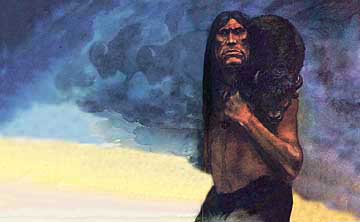
|
|
|
A depiction of a North American giant, based upon Native American legends. Native Americans believed that the first peoples to inhabit
Earth were a race of gigantic Indians. These giants did not respect the Great Spirit, committing crimes against both man and nature,
so the Great Spirit sent a Great Flood to destroy them.
Image from Julek Heller's
Giants.
|
|
America's ancient past was in many ways vastly different than the picture painted by mainstream science. Though most, if not all of what the textbooks say about ancient America is historically correct, the problem lies not with what they do say, but with what they do not.
Though "mainstream" scholarship insists that giants are figments of our imagination, the myths and legends of the Native Americans tell a different tale:
A tribe of North American Indians believes that the first human beings on the Earth were a race of gigantic Indians — so large that even the mighty buffalo was dwarfed by their size. Such a giant Indian could lift a full-grown buffalo bull from the ground and throw it over his shoulder, carrying it back to his encampment effortlessly. A yearling to him was so small he would simply hang it from his belt as a hunter today might do with his rabbit. These giant forebears had no fear of any superior power, had no notion of a life after death and did not believe in
Ti-ra'-wa, the all powerful one who watches over the destiny of man. So the giants did as they pleased with no regard for the consequences. Finally, when the deeds they perpetrated had reached unacceptable proportions, Ti-ra'-wa resolved to punish the big men. He caused the waters of the rivers, lakes and seas to rise up until they were level with the land. The ground became soft and the heavy giants sank down into the mud and were drowned. Even today massive bones are still found in remoter areas of North America.24
This description of the destruction of the giants of North America fits very closely with the Hebrew conception of how the giants were
destroyed by the Flood,
as evidenced by the Bible and related texts. Also like the Israelites, Native American legends tell how their ancestors had also fought and destroyed remnants of these fearsome warriors when they had migrated to North America.
Like the
Elamites
and
Israelites
of
the ancient Near East,
whom YHWH had sent to destroy the giant
Rephaim
and
Anakim
of that region,
the ancient ancestors of our modern Native Americans, under the guidance of the "Great Spirit", had defeated the wicked, abhorrent giants of the Americas. As a result of their victories, they were given the lands that the giants had formerly inhabited, just as the "Great Spirit" had done with the Israelites.

|
|
|
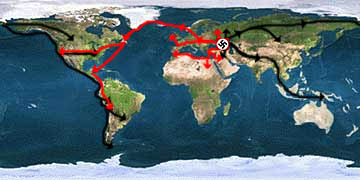
|
|
|
DNA, historical and linguistic evidence indicates that two different groups of Indo-Aryan Kurgans invaded east and west from an origin point
in the Caucasus starting sometime during the second millennium b.c. When the two divisions of the red-bearded (X1 Haplogroup) and black-
bearded (X2 Haplogroup) giants met in the
Americas, civil war was a result, with the red-beards winning. Both divisions also made significant inroads into Central and South America.
One or both divisions also invaded south into Palestine as well, but they were turned back by the Israelite conquest.
|
|
The Great Flood of
Noah
probably took place around 9500 b.c., at the end of the last Ice Age. Though the Great Flood had wiped out the giants all over the world, after the Flood the fallen angels had immediately restarted their "master race" program, and the giants returned to the Americas with the same gusto they had brought with them to the ancient Near East. During the time of Abraham, around 2000 b.c., as we have seen, the Kurgans began to expand outwards from their central Asian homeland and began invading in all four directions: north, south, east, and west. The most popular and best supported theory for the fate of the Kurgans and their Indo-Aryan allies was that they eventually conquered and became assimilated with the Russians in the north, the Iranians and Canaanites in the south, the Mongols and the Indians in the east, and the Europeans in the west. However, recent evidence, even more conclusive than the strong archaeological, linguistic and other evidence, has proven that their conquests were even more extensive than previously thought, reaching even North America. This definitive evidence of a Kurgan invasion into the Americas during ancient times can be found in the form of mitochondrial DNA:
DNA analysis on Native Americans
began in the 1980s, but with rapid technological improvements, research intensified in the early 1990s. Several teams of genetics researchers at prominent American universities have been conducting numerous studies. Although results from early studies showed the expected Siberian-Asia ancestry of the majority of modern Native American tribes, things took an unexpected turn in 1997. At that point it was found that a small percentage of modern Native Americans have an unusual type of DNA then known to exist only in a few locations in Europe and the Middle East. Subsequent research indicated that the European DNA was not the result of genetic mixing after Columbus. In addition, the same DNA was later found in the bone of an ancient American burial confirming that people carrying this unique DNA had entered America in ancient times. However, in July 2001, this unique gene was also found in a small tribe living in the northern Gobi Desert area. The DNA research initially seemed to promise solid proof of not only where the ancient Americans came from, but also when they came.25
In 1997, a European-type strain of mitochondrial DNA was found in 3 percent of the Native American population. This strain, known as
"Haplogroup X"
differs from the Siberian, Japanese and Polynesian strains, known as groups A, B, C and D, that dominate the Native American genome.
Haplogroup X
can be further subdivided into two "subhaplogroups": "X1", and "X2". X1 is primarily found in northern and northeastern Europe, whereas X2 is found in the Near East, Central Asia, the Caucasus, Siberia and — you guessed it — North America. As such, the belief that
Europeans had visited the Americas in ancient times
has been confirmed beyond a shadow of a doubt. And the "genetic footprints" that they left behind clearly point to a place of origin in Central Asia and the Caucacus — the ancient homeland of the Kurgan.
We have now confirmed, via DNA evidence, that the Indo-Aryans had indeed invaded the Americas in ancient times — possibly several times in several different waves stretching over a period of thousands of years, beginning as early as 9000 b.c., by some estimates. Moreover, the existence of two different strains of Haplogroup X, X1 which traveled west from the Caucasus, and X2 which traveled east, implies that two different tribes of Kurgan may have reached the Americas — X1 from the east via Greenland, and X2 from the west via the Bering Straits. Is there evidence in Native American myths and legends of two invading peoples coming from both east and west in ancient times? In fact, there is.

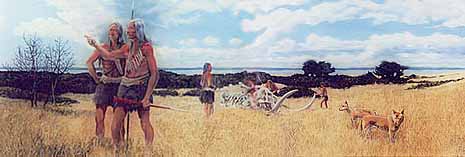
|
|
The small extended-family group above represents
"Red Paint People"
displaced about 9,000 years ago from the Atlantic coastal plain into familiar New England landscapes. They set up the oldest navigational guides along these coasts with their standing-stones, and carved tools of stone, bone and ivory into stunningly life-like images of killer whales and other creatures---works that rival (and even resemble!) the craftsmanship of ancient Europe at this time. Red ochre, or iron oxide, they used for purposes both spiritual and practical — as an honorific in burials and sites, and as protection from sun and insects.
Image from
AncientGreece-EarlyAmerica.com.
|
Save perhaps the account of the giants being destroyed by the Flood, the oldest account of giants living in the Americas can be found in the traditions of the
Chippewa (Minnesota),
Sandusky and
Tawa tribes (both of Ohio). These traditions tell of a race of black-bearded giants that had first conquered and ruled North America, but had been conquered themselves by another race of red-bearded giants:
In this connection I would say that Mr. Jonathan Brooks, now living in town, stated to me, that his father, Benjamin Brooks, who lived with the Indians fourteen years, and was well-acquainted with their language and traditions, told him and others that it was a tradition of the Indians that the first tribe occupying this whole country, was a black-bearded race, very large in size, and subsequently a red bearded race or tribe came and killed or drove off all the black beards, as they called them.
— The Firelands Pioneer (1858)26
Beards are only found in European, Middle-Eastern, and some African peoples, but only very rarely in Asiatic peoples, which make up the majority of the Native American genome. Despite this, Native Americans believe that not one, but two types of bearded peoples had at one time occupied the Americas. And not only were they bearded, they were giants as well.
They also say that the black-bearded race that had once occupied the Americas had been driven off by a red-bearded race of giants. Could this have
|
This red-headed mummy was one of many found in the Takla Makan desert in central Asia, in the far northwestern corner of China.
Though many mummies have had typical Asian features, this and many more displayed distinctly European features. This ancient beauty forms a
link to a part of humanity's ancient past that had previously been forgotten. Image from
NOVA Online.
|
been a fateful meeting between the two divisions of the ancient Kurgans, one defined genetically as Haplogroup X1, and the other defined as Haplogroup X2?
As we have seen, the X1 group of Indo-Aryans had migrated north and west, settling central, northern, and western Europe, whereas X2 had migrated through the Takla Makan desert, along the old
Silk Road
(where blonde and red-headed mummies 3,000-4,000 years old have recently been discovered),
through Mongolia, Siberia, and finally through Alaska into North America, where they conquered and eventually integrated with the Native Asiatic peoples. The X1 group of Kurgan then likely migrated from Britain, Ireland and Scandinavia to North America via Iceland and Greenland, just as the Vikings would do thousands of years later. When the X1 "red-bearded" group invaded North America and met the X2 "black-bearded" group who had long since assimilated with the native Asiatics, the more "pure-blooded" Aryan red-bearded giants likely did not recognize them as distant relatives and instead attacked and destroyed the black-bearded giants, leaving only a small remnant of them behind. Interestingly, as we have seen, when the Vikings had sailed from Greenland to Newfoundland around 1000 a.d., they had found native peoples with light skin and dark hair called the Beothuks, some of which had blonde hair. Could these Indo-European remnants have been the last of the "red-bearded" peoples that had invaded and destroyed the black-bearded race, later becoming assimilated with the more numerous Asiatics?

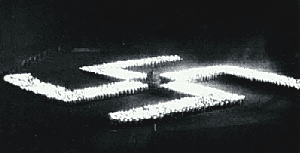
|
|
|
This image is of an occult ceremony wherein the Nazis were attempting to reenergize the ancient Aryan gods in order to gain the power to defeat their enemies and conquer the world. Each stormtrooper held a torch and walked in a circular procession, literally bringing to life the ancient sunwheel, or "black sun" that was the swastika. However, this "black sun", instead of bringing light and life,
like a black hole
conquers and devours all it touches. As we have seen, Hitler was not the first Caucasian to use the swastika as a symbol of conquest, as seen by its presence in North America related to the Aryan Invasions.
Image from
Black Sun: The Mythological Background of National Socialism.
|
|
A pattern seems to be emerging of a series of waves of migration and conquest that originate from central Asia — specifically, two primary waves of conquest that circled around the world, east and west, meeting in North America where the two bands of Indo-Aryans, one now with dark hair due largely to intermarriage with Asiatics, and one still relatively pure "Aryan", routinely meet and battle for supremacy over the Americas. If this is true, this would make it clear that the red-bearded giants were the X1 group of Indo-Europeans, invading North America from the east, from Europe, whereas the black-bearded giants were likely the X2 group of Indo-Europeans that had invaded North America from the west, from Asia.
Could this repeating pattern of conquest be a cycle of history that is just now beginning to be understood? The Norse myths tell of an ancient war between the
Aesir and Vanir,
two groups of divinities that were gigantic in stature — could the enmity between the Aesir and the Vanir been an echo of an ancient civil war amongst the Indo-Europeans that sent one group east, and the other west, which created the different X1 and X2 Indo-European haplogroups? If so, this ancient, recurring political division in central Asia might explain the mysterious references in the Bible to
Gog and Magog,
two kings who come from central Asia and attempt to conquer the world in the end times.
In fact, the Bible prophecies that Gog and Magog will attempt to conquer the world not once, but twice: during the tribulation period, as described in
Ezekiel 38,
and again after the 1,000 years of messianic rule, as described in
Revelation 20. Perhaps not by accident, the name "Gog" sounds much like the name
"Og",
one of two giant Rephaim who once ruled over the Amorites in Canaan. Also very telling is the fact that the ancient Indo-Europeans also worshiped a pair of
twin gods,
two conquering kings who were associated with white horses that correspond closely with the gods Castor and Pollux of the Roman myths. This sort of "schizophrenic rule" between two great divisions of the Indo-Europeans — led by two charismatic leaders — seems to be normative in the history of the Indo-Europeans, a fact that neatly ties in with our previous study of the Nazi fascination with
twins,
as well as their tendency towards violence and schizophrenic behavior.

|
|
|

|
|
|
This classic image from the German propaganda machine shows Hitler as a sort of messianic figure of the "Aryan" race, complete with false "dove" over his head,
a bastardization of the dove that ascended upon Christ after his baptism by John. Was Hitler the return of
Azazel?
Image from
Calvin College: German Propaganda Archive.
|
|
Over and over it appears that
the Caucasus,
the homeland of the Kurgan, has played a role in world war scenarios. World War I started after the
Archduke Francis Ferdinand, heir to the Austria-Hungarian throne, was assassinated in Sarajevo, Bosnia, by a Serbian nationalist. Bosnia is on the border of central Asia, not far from the Caucasus. World War II, of course, was started by Adolph Hitler, who was attempting to revive what he referred to as the "Aryan race", which he believed had its homeland in the Caucasus. Interestingly, the final battle of Gog and Magog, which also comes forth from the Caucasus, involves the nations from "the four corners of the earth" — a possible allusion to the four winds/swastika concept that seems to be part and parcel of this cyclical "fascist" movement that appears to come forth from the Caucasus on a regular basis. This fascist movement, as we have seen, involves a "four-front war": one moving north, into Russia, one moving south, into Palestine, one moving east, into Asia, and one moving west, into Europe, with the eventual goal of the eastern and western campaigns meeting up in the Americas. This is what happened with the Kurgans over 4,000 years ago (possibly several times), and was attempted again by Hitler again in 1939.
|
|

|
|
|
Joseph Stalin,
absolute leader of Russia from 1922-1953. Stalin was born in Georgia, near in the Caucasus, the heartland of the Indo-Europeans.
In the photo, the Caucasus, his homeland, is located over his right shoulder, and he points upwards, towards Russia. Though Stalin was
somewhat less charismatic figure than Hitler, he was no less powerful, nor brutal. Was Stalin the return of
Semjaza?
|
Interestingly, World War II featured not one but two megalomaniacs:
Adolph Hitler, and
Joseph Stalin.
It has been remarked by many that these two infamous dictators in many ways led
parallel lives.
Both dictators were born near or in Central Asia: Hitler in eastern Austria, and Stalin in the republic of
Georgia.
Georgia
is, of course, where the
Caucasus Mountains
are located, the heartland of the ancient Indo-Aryan Kurgan. Not only were the histories and upbringing of these men very similar, but their political theories were also similar. Hitler believed in a form of
fascism
called
National Socialism,
and Stalin, who was not a true communist by any means, believed in a form of socialism called
Social Fascism.
Stalin believed that
social democracy
as preached by Marx and fascism were really one and the same. Thus, in his mind, he and Hitler were just two sides of the same coin — two dictators, one to rule the east, and one to rule the west, two towering wills to shape the destiny of man. However, Hitler had no interest in sharing power — he had his mind set on only one thing: to rule them all.
Hitler saw Communism in general and Stalin in particular to be his mortal enemies. The non-aggression pact that was signed between the two peoples was merely a delaying tactic to give Hitler time to secure his western front so as to help ensure victory over the hated Communists. However, Stalin for some reason was convinced that Hitler would not break the treaty. Thus, when Hitler reneged on his non-aggression treaty and blitzed into Russia, his
southern thrust
heading straight for the Caucasus, Stalin was caught completely by surprise. Perhaps this is similar to what happened to the Kurgans in ancient times as well — civil war, that led to the division of the race into eastern and western branches, led by the same Gog and Magog of legend? Were Hitler and Stalin the return of these two ancient villains, battling all the world — and each other — for world domination? Will these fallen angels rise again in the end-times — using different faces, and different names — to try to conquer the world once more?

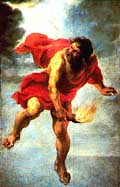
|
|
Prometheus
was one of the "titans", a group of semi-divine beings in the Greek myths that rebelled against the gods. Prometheus,
one of the leaders of the rebellion, stole the secret of fire from Zeus and gave it to mankind. Prometheus was also
closely involved with the
creation of man.
|
|
Why does this "bipolar fascist" movement recur cyclically and, furthermore, why does it emanate from the Caucasus? Is there an ancient power or powers emanating from this region that moves men to do great violence, a power that has designs on conquering the world?
A particularly interesting bit of information that may shed light on this question can be found in a legend of Gog and Magog involving Alexander the Great, who, "while conquering the world, came eventually to the Caucasus Mountains where
Prometheus
the Titan had been chained long before."27
This Greek myth of the chaining of an ancient titan may be the same story that the Book of Enoch describes as the chaining of the most powerful of the ancient fallen angels,
Azazel,
the angel that had led all the rest into rebellion.
This would explain why this region has long been associated with war, particularly technologically sophisticated war (bronze and iron weapons, war chariots, etc.), as Azazel's particular skillset had to do with the development of weapons of war. Prometheus, interestingly, was one of the titans of Greek mythology who had stolen "fire" from the gods and given it to man, just as the fallen angels had taken the heavenly secrets of technology and given it to man — fire is the most basic form of technology that allows the development of all the rest. If indeed Azazel was buried and trapped under the Caucasus, just as Prometheus had been "chained" there, it could be conjectured that the swastika is the symbol of Azazel, and those who use the symbol are attempting to magically summon his power for use in conquering their enemies. This would explain the otherwise seemingly pointless fascination the Nazis had with the symbol, incorporating it as the central focus of their midnight occultic rituals, and emblazoning it on absolutely everything in their inventory. In their minds, the power of the "dark sun" was very real, and by using it they were resurrecting its ancient, evil power for their use in
modern times.
The giving of technology to man,
as we have seen,
caused a great imbalance in man and nature that had to be reconciled with a Flood that destroyed all life on earth, save those kept safe on the ark. As it is described in the Book of Enoch,

|
|
As part of his punishment, Zeus chained
Prometheus
to the Caucasus mountains, where he remains to this day. Part of the myth describes how an eagle swoops down and eats his liver every
day, the liver regenerating during the night so it can be eaten afresh each day. What might this act symbolize? Send your thoughts to
publisher@mysteriousworld.com.
Image from
Encyclopedia Mythica.
|
|
1Then said the Most High, the Holy and Great One spake, and sent
Uriel
to the son of Lamech,
2and said to him: Go to Noah and tell him in my name "Hide thyself!" and reveal to him the end that is approaching: that the whole earth will be destroyed, and a deluge is about to come
3upon the whole earth, and will destroy all that is on it. And now instruct him that he may escape
4and his seed may be preserved for all the generations of the world. And again the Lord said to
Raphael:
Bind Azazel hand and foot, and cast him into the darkness: and make an opening
5in the desert, which is in Dudael, and cast him therein. And place upon him rough and jagged rocks, and cover him with darkness, and let him abide there for ever, and cover his face that he may
6,7not see light. And on the day of the great judgement he shall be cast into the fire. And heal the earth which the angels have corrupted, and proclaim the healing of the earth, that they may heal the plague, and that all the children of men may not perish through all the secret things that the
8Watchers have disclosed and have taught their sons. And the whole earth has been corrupted
9through the works that were taught by Azazel: to him ascribe all sin. And to
Gabriel
said the Lord: Proceed against the bastards and the reprobates, and against the children of fornication: and destroy [the children of fornication and] the children of
the Watchers
from amongst men [and cause them to go forth]: send them one against the other that they may destroy each other in
10battle.28
According to the Book of Enoch, Azazel/Prometheus had not only given men the gift of technology, he had also meddled with their genetic structures to create the giants, "the children of the Watchers", as a "master race" of unbeatable warriors that he intended to use to conquer the world. "The Watchers" were those angels who had been directed by God to oversee God's creation, but had instead meddled with it so as to turn it to their own advantage, thus becoming rebel, or "fallen" angels. Along with Azazel fell another powerful angel,
"Semjaza",
with whom it appears he shared the rule, at least, to a certain extent. It may be that Azazel and Semjaza actually struggle with each other for who actually has control, a conflict that is responsible for the ancient and recurrent division among the Indo-European races. This would explain the consistent appearance of "twin" rulers of the Indo-Europeans throughout history, the most recent being Hitler and Stalin. Were Hitler and Stalin the return of Azazel and Semjaza? The Book of Enoch says that both of these fallen angels were buried and placed in chains until the end times, when they will be released one last time to wreak havoc on the Earth. Was World War II just a warmup for the main event?
|
|
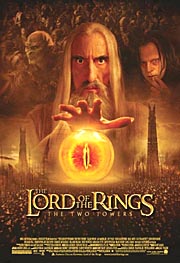
|
|
|
In
The Two Towers,
the character
Saruman
was seduced by the dark side and turned his abilities towards evil. This evil took the form of abandoning nature and instead
embracing industrialization, the most horrid aspect of which was the genetic manipulation of orcs (homo neanderthalis) and
other primitive forms of mankind (homo erectus, Cro-magnon)
to create a larger, stronger form of hybrid footsoldier (homo artificialis) that he intended to use to destroy the human
race (homo sapiens). Interestingly, if one were to interpolate
the map of Middle Earth over a map of Europe, Saruman's tower would be in Central Europe, and
Sauron's
tower would be in the Caucasus. It may be that Tolkien intended Saruman and Sauron to be symbolic of Hitler and Stalin,
possibly even Gog and Magog, two towering wills ready to unleash their genetically modified armies on the Earth.
Image from
Lord of the Rings.net.
|
|
If Azazel and Semjaza were indeed both imprisoned under the Caucasus, it would explain a great deal. These wicked beings had attempted to create a master race of giants in the world before the Flood, and had been punished and imprisoned for doing so. However, they still attempt to recreate the world the way it was before the Flood, creating armies of giants to conquer it, but are now limited by their imprisonment so that their attempts, though powerful, consistently fail. Now they remain chained "between the pillars", awaiting their day of release, the "pillars" being Mount Elburz, a twin-peaked mountain located in the Caucasus, also known as ubera aquilonas, or "the Breasts of the North". In the Alexandrian legend of Gog and Magog mentioned previously, Alexander had magically moved those mountains together and built an adamantite gate between them to keep Gog and Magog and their hordes from invading south into the civilized lands, a gate that will be opened in the end times to let Azazel and Semjaza, aka "Gog and Magog", to conquer the world.
After Azazel and Semjaza were imprisoned, God then decreed that their progeny, the giants, who were poisoning and destroying the whole of God's Creation, were to be destroyed in a Flood. However, before He sent the Flood to destroy the giants and cleanse Earth from their poison and corruption, He had sent the archangel Gabriel to set the giants against each other so that they would destroy each other in a massive civil war. This civil war was likely a world war, as was discussed in our series on legendary
Atlantis,
where we had theorized that the giants had built the mighty empires of Atlantis in the Atlantic Ocean,
Osiria
in what is now the Mediterranean Sea, Rama, which is now sunken off the coast of India, and other areas of the world. These various empires had, according to esoteric tradition, gone to war with each other in the time right before the Flood, giants fighting against giants. The giants apparently fought against and destroyed each other on every continent until the Great Flood came and wiped them, the poisons their weapons created, and the corruptions they had wrought off the face of the earth.
However, as we saw in
Part I,
this was not the end of the giants. Immediately after the Flood had subsided, Azazel, Semjaza and the other rebel angels began recreating the giants of old, manipulating the human genome to increase their size and strength, and giving them improved war technology in order to conquer and enslave the "inferior" homo sapiens that God had created and saved from the Flood. Ever since the Flood, attempt after attempt to raise an army of giants and conquer the world has been undertaken, each time using the Indo-Europeans as their primary resource of manpower. Each attempt has failed, however, the giants gradually being worn down and outcompeted for resources by the more numerous and more efficient homo sapiens. However, though these attempts to conquer the world have all failed, they have left mighty, jack-booted footprints all over the world, including the myths and legends of the Americas. And along with these genetic and linguistic footprints, the ancient Indo-Aryans left the symbol of Azazel: the swastika.

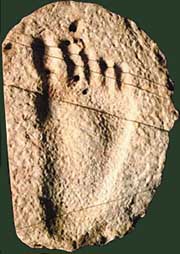
|
|
|
The Burdick Track, found near Glen Rose, Texas, famous for its dinosaur tracks. This track was found in Cretaceous limestone,
the same level that a number of dinosaur tracks were also found. The track is 13-1/4" long, making the person who made the
print over 7 feet tall and weighing in excess of 300 pounds.
Image from
The Interactive Bible.
|
|
Not surprisingly, the giants in the histories and myths of the Native Americans were almost entirely evil in nature. Ruthless, greedy, aggressive, cutthroat and cannibalistic, they were in every way evil. Not surprisingly, based upon our "Aryan Invasion" paradigm, the myths portray the giants as being blonde or
redheaded
as well, and even say that these giants came from across the sea, the home of the giants:
Giants are a malignant race who flourished in primordial times before they were brought into check by the great spirits. Although they would frequently sojourn on the island earth where humans live, their home is in a Spiritland on the other side of the Ocean Sea. Since two Wolf Spirits reached it floating on a small ice berg, it apparently lies in the arctic north. There the wind blows cold and fierce, and the ground can be covered in snow. On the other side of the ocean, tribes of Giants flourished. Some of them protected their mortality by removing their hearts and wrapping them in bundles of feathers which they hid away on a platform. These Giants were killed by the Thunderbird, Ocean Duck, who found their hearts and burned them to ashes. Like other spirits, the Man Eaters can be divided into two tribes: the Good Giants and the Bad Giants. Most seem to have belonged to the tribe of Bad Giants who indulge their appetite for human flesh, but the Good Giants have belied their name by abandoning the practice of eating people. Originally, they too had eaten people, but the spirit called "Young Man Gambles Often" (Hotc�tc�wagiogega), caused them to vomit up everything within them, until finally they disgorged ice from their stomachs. This it was that caused them to eat humans. After that, they enjoyed the same food that humans ate. While the stomachs of Giants contain ice, their heads contain wampum, which is to say, sea shells.29
The giants were clearly understood by the Ho-Chunk (Winnebago) Indians as having come from across the sea, from the arctic lands of Greenland, Iceland and Scandinavia. This was their home, the home of what we now know to be the X1 haplogroup of Indo-Aryan giants who had conquered their way all the way from the Caucasus to the fjords of Norway and beyond, all the way to Iceland, Greenland, and finally to North America. The interesting reference to "removing their hearts" may be a reference to the heartless brutality that the giants displayed, killing and pillaging indiscriminately, and even devouring their captives. The reference to wrapping their hearts in feathers and hiding them on a platform may be an oblique reference to the practice of human sacrifice that was practiced in Central and South America until only a few centuries ago, a practice that may have been taught to them by the wicked giants. The "platform" probably refers to the massive pyramids atop which the sacrifices were performed, where the hearts of the victims were removed and sacrificed to the sun god. It may be that in the process of sacrificing their hearts to the sun god, the hearts had been wrapped in feathers and then burned. It may be also that human sacrifice had been carried on in North America at such centers as
Aztalan
and
Cahokia,
that also have platform mounds, though there is no evidence of human sacrifice in North America known to date.
A young hero named, essentially, "risk-taker", challenged the giants and forced them to vomit up the ice from their stomachs, the "ice" likely being an Indian metaphor for being cold and remorseless — what we would call "cold-hearted". Thus rid of the "ice" in their hearts, they saw that what they were doing was wrong, and stopped eating humans. However, their heads were still full of wampum, that is to say, sea shells, which were the unit of currency on the sea coast. Therefore, the concept of their heads being "full of wampum" meant that they still were greedy, and continued plundering and pillaging. Interestingly, the idea of the giants being cold and empty inside, needing to fill the void with material pleasures and wicked activity fits in very well with the concept of giants arrived at in
Part I.
Not only are the Giants by nature man eaters, as their Hotc�k name W�nger�tcge reveals, but male Giants are as tall as trees, four times the height of a man. On the other hand, Giant women, who are particularly noted for their beauty, are about the same size as humans. Despite the hostility and dietary proclivities of Giants, humans are part Giant themselves. Once humans were smaller and rather uniform in size. In ancient times men took Giant women as brides, and over time the admixture of the two bloods produced a race of variable heights such as we are today. Particularly large humans merely take after their Giant ancestors. Some large human men are thought to be reincarnations of Giant Spirits, usually of the Good Giant tribe, judging by their benevolence. One cannibal Giantess, some call
"Pretty Woman,"
had hair said to be, variously, red, orange, or yellow. Despite her superior skill in lacrosse, her life was spared by the victorious good spirits, and she was adopted into human society.30
The giants were naturally cannibalistic and, in the Ho-Chunk legends, over 20 feet tall. Interestingly the story also explains about how many Indian tribes, all of whom were apparently black-haired, were already part giant. However, the invading blonde and red-haired giants were much taller, indicating perhaps that they were purer "Aryan", and had not intermarried with smaller races. Along these lines, the reason given for why some Indians are taller than others is because they had made treaties and intermarried with previous waves of invading giants, effectively neutralizing them, and in the process creating a race of taller, stronger Asiatic Native Americans. This must have been the fate of the X2 group of giants that had invaded from Asia: they had eventually intermarried with the Asiatics, with the net result that, when the X1 group of Kurgans had invaded North America from Europe, they found it being ruled by a race of dark-haired, large men, 7-8 feet tall, rather than blonde and red-haired giants ranging in height from up to 12 feet tall or taller.
Interesting details about the conflicts between the native, dark-haired, tall hybrid giant Indians and the invading red- and blonde-haired "purer" giants have also been retained in the story of "Pretty Woman". Interestingly, even this newer, more aggressive breed of giants invading from Europe eventually ended up interbreeding with the native black-haired Asiatics.

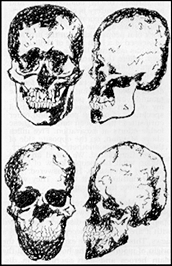
|
|
|
Male and female Adena skulls. The Adena migrated from the south into the Ohio Valley approximately 1000 b.c., conquering and ruling over
a more gracile, "long-headed" population, as was the case in Central Asia. Note the rounded skulls and the massive jawbones with
prominent bilateral protrusions, or "cleft chins".
Image from
The Q-Files.
|
|
Though this story of Asiatic giants meeting and being defeated by European giants in ancient times may seem fanciful, even ridiculous, once again the traditions of the Native Americans, as well as the archaeological record, bear true witness to America's giant past. Perhaps one of the most obvious but seldom referenced giant peoples of the past are the mysterious "Adena" people.

Around 1000 b.c., at the boundary between the end of the Archaic Period and the beginning of the Woodland Period of North American history, a new people moved into the Ohio Valley from the southwest. These were an intelligent and fairly civilized people, more commonly known as the Adena. And unlike the native populations of the Ohio Valley, which were relatively average in height and slender in build, the Adena were tall, and powerfully built.
As Silverberg explains in his classic,
The Mound Builders
It seems clear that the Adena people were intruders in the Ohio Valley, representing not merely a new cultural tradition but a new physical stock. The Archaic inhabitants of the region were mainly long-headed, with narrow skulls and slender bodies.... The Adena folk were quite different, [having] a large round skull, prominent forehead, heavy brow ridges, jutting chin, and massive bones. The Adena folk were unusually tall; bones of women over six feet in height and men approaching seven feet have been discovered. This band of people of great majesty and size forced its way into the Ohio Valley about 1000 b.c., it seems.... Perhaps there was a small elite of round-headed giants dominating and ruling an existing long-headed Ohio Valley population. But the question remains: where did the mound-building Adenas come from?31
|
|
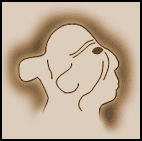
|
|
|
Outline of the head of a statue of a woman found in the bottom land of the Ohio River near Tolu, KY.
Image from
Serpent Mound Mysteries.
|
The Adena
were a short-headed, or "brachycranic" people, meaning that their heads were nearly round, as opposed to the more "long-headed" and narrow skulls of the Archaic peoples that preceded them in the region. The Adena even practiced cradleboarding, so as to accentuate this domelike shape. The Adena also has prominent, massive jaws and cleft chins, a trait that is typical of giants, as we have seen. The larger, stronger, and possibly more intelligent Adena appear to have conquered and taken the rule over the smaller, "long-headed" peoples of the Ohio Valley, a pattern identical to that which occurred in Central Asia, where the more massive, round-headed Cro-Magnon had also moved in and defeated the existing long-headed population.
Similarly,
as we have seen,
with the Adena began the era of mound building in the Ohio Valley. This makes sense, as it is most likely that the Adena were in fact the last stages of a Kurgan invasion, the original Kurgans having been assimilated by several generations of Asiatics until the Adena, who were no longer giants but merely tall, spent the last of the fury of the original Kurgan invasion with one final conquest: the Ohio Valley. If they were indeed the last leg of a Kurgan invasion, it is likely that they would have retained some of the practices of their Kurgan forebears. This of course, would explain the moundbuilding, as the Kurgan had been the moundbuilders par excellence from ancient times. Thus, it is likely that the Adena were a Kurgan/Asiatic hybrid giant race, of the same pedigree that had been destroyed in times past by invading European giants.

One of the more enigmatic references to giants in the legends of the Native Americans was a legend of the
Tuscarora
of a giant people named the "Ronnongwetowanca". These people once had ruled over the Ohio Valley for some time prior to 1000 b.c., ruling over what was described by the Native American storytellers as "a considerable habitation". As Hamilton explains,
David Cusick, a Tuscarora by birth, writes in 1825 that among the legends of the people of the ancient stock, there was a powerful tribe called Ronnongwetowanca. They were giants, and had a "considerable habitation." He says that when the Great Spirit made the people, some of them became giants. The giants were said to have had a "silly" mode of attack, waiting until their intended victim was not expecting anything. After a time, and having endured the outrages of these giants, it is said that the people banded together, and through the final force of about 800 warriors, successfully annihilated the abhorrent Ronnongwetowanca. After that, it was said that there were no giants anywhere. This was supposed to have happened around 2,500 winters before Columbus discovered America, i.e., around 1000 B.C.E. — the time that the Adena seem to have arrived in the Ohio Valley.32
As Hamilton alludes, the Ronnongwetowanca were likely wiped out by the invading Adena, who had made their first appearance in the Ohio Valley region around that time. Though the Adena were also tall and robust, they were not true "giants", as we have seen, at least not like the Ronnongwetowanca. Another peculiarity of the giants may be seen here as well: they tended to behave in a bizaare and deceptive, or "silly" manner, in order to confuse their opponents, perhaps to give them a false sense of security. Based on this, one might surmise that these giants may have feigned peace treaties with potential rivals in order to gain the advantage of surprise over them, and wipe them out with little resistance. This may have been what Hamilton refers to as "the outrages of the giants", and may have been one of the main reasons for how they had taken the rule over the Ohio Valley: their
Machiavellian techniques,
as well as their large size, gave them an edge that was difficult to overcome.
Few details are known about the Ronnongwetowanca, so we cannot determine whether these giants were red-bearded or black-bearded, if indeed they had beards at all. Nor can we fit them into our Asiatic/European giants paradigm, as we could the Adena so, for now anyway, they remain one of the ancient unsolved mysteries of America's giant past. Some certain information can be derived from this bit of information from the Tuscarora elders, however: the Ronnongwetowanca were believed to have been the last of the giants in North America.

Another enigmatic fragment of North America's giant history can be found in the legend of the Alleghans. The Alleghans, who gave their name to the Allegheny Mountains, were a very tall and strong people who once dominated the eastern United States. It was also believed by some that they were the oldest tribe in North America.
The oldest tribe of the United States, of which there is a distinct tradition, were the Alleghans. The term is perpetuated in the principal chain of mountains traversing the country. This tribe, at an antique period, had the seat of their power in the Ohio valley and its confluent streams, which were the sites of their numerous towns and villages. They appear originally to have borne the name of Alli, or Alleg, and hence the names of Talligewi and Allegewi. By adding to the radical of this word the particle hany or ghany, meaning river, they described the principal scene of their residence namely, the Allegheny, or River of the Alleghans, now called Ohio. The word Ohio is of Iroquois origin, and of a far later period; having been bestowed by them after their conquest of the country, in alliance with the Lenapees, or ancient Delawares. (Phi. Trans.) The term was applied to the entire river, from its confluence with the Mississippi, to its origin in the broad spurs of the Alleghanies, in New York and Pennsylvania; and the designation, to its sources, is still continued in use by that people.
From the traditions of the Lenapees, given to the Moravian missionaries, while the lamp of their traditional history still threw out its flickering but enlivening flames, the Alleghans had been a strong and mighty people, capable of great exertions and doing wonders.33
The story of the Alleghans come from the Lenni Lenape, whose descendants are better known today as the
Delaware.
The Lenni Lenape, a tribe of normal height and build, had originally migrated from the west, at the bidding of the "Great Spirit". At the river crossing of the Mississippi, they had met up with another people known as the Mengwe, with whom they became allied. Then, in a manner very similar to the way in which the
Israelites
had approached the land of Canaan, the Lenni Lenape sent out scouts to "spy out the land"
|
|
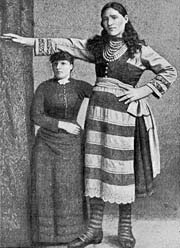
|
|
|
Russian giantess, original source unknown. The Lenape spies described the giants as so tall that "the head of the tallest Lenape could
not reach their arms." This giantess is close to 8 feet tall, as well as being proportionally larger and stronger. The Kurgan probably
looked much like her, as Russia is just north of the Caucasus. Note that her facial features are not dissimilar to those of modern Native
Americans.
Image from
The Q-Files.
|
They told, that they had found the further bank of the River of Fish inhabited by a very powerful people, who dwelt in great villages, surrounded by high walls. They were very tall, so tall that the head of the tallest Lenape could not reach their arms, and their women were of higher stature and heavier limbs than the loftiest and largest man in the confederate nations. They were called the Allegewi, and were men delighting in red and black paint, and the shrill war-whoop, and the strife of the spear. Such was the relation and made by spies to their countrymen.34
Like the Israelite spies, the Lenni Lenape spies brought back a report of giants in the Earth, even using terminology that is strikingly similar to that used in the Bible.
(Numbers 13)
Also, like the giants that the Israelites had conquered in Canaan, the giants of the Ohio Valley lived in high-walled cities, indicative of a relatively sophisticated culture. Moreover, they were not merely tall, but huge, their description indicating a people that were large and powerful, possibly in the 8-9 foot range in height, or even taller.
Interestingly, like the Kurgan and the Red Ochre People, these people painted their entire bodies in red — or black — paint, and were extremely warlike in nature.
The Lenni Lenape then sent messengers on to the Alleghans, or "Allegewi", in order to try to establish formal relations with these formidable people so they could pass by them unscathed. However, true to their Machiavellian nature, as the Lenni Lenape began to cross the Mississippi, the giant Allegewi broke their promise and attacked them when they were at their most vulnerable.
They sent a message to the Allegewi to request permission to settle themselves in their neighborhood. This was refused them, but they obtained leave to pass through the country and seek a settlement farther to the eastward. They accordingly began to cross the Namesi Sipu [Mississippi River], when the Allegewi, seeing that their numbers were so great, and in fact they consisted of many thousands, made a furious attack on those that had crossed, threatening them all with destruction, if they dared persist in coming over to their side of the river. Fired at the treachery of these people, and the great loss of men they had sustained, and besides, not being prepared for a conflict, the Lenape consulted on what was to be done; whether to retreat in the best manner they could, or try their strength, and let the enemy see they were not cowards.35
As a result of the treacherous attack, the Lenni Lenape consulted with their Mengwe allies, and decided that a war was necessary to bring the giant Alleghans to heel. As the wicked intentions of the Alleghewi was evident, it became clear that these giants, with their "silly" mode of attack, could not be trusted, and might have to be exterminated. Thus followed a long war with the Alleghewi that, despite their great size, strength, and superior skill in battle, resulted in an eventual loss for these mighty giants of the Ohio Valley. Worn down by the superior numbers and steely resolve of their smaller foes, the wicked Alleghans were wiped from the face of the Earth (though a variant version of the tale has a remnant of the giants escaping down the Mississippi). Heaps upon heaps, their giant bodies were buried in place in hundreds of burial mounds.
After their successful, but costly battle, the Lenni Lenape and the Mengwe went their own separate ways. Whereas the Lenni Lenape would migrate further east to become the Delaware, the Mengwe would migrate north to become the part of the Iroquois
six-nation confederacy,
later becoming bitter enemies of the Delaware, their former allies. Among these Iroquois were the Tuscarora which, as we have previously seen, had kept a tradition of an ancient tribe of giants known as the Ronnongwetowanca, that had been destroyed by a confederation of several tribes, including their own. Most likely, the Ronnongwetowanca and the Alleghans were the same or closely related peoples, and their destruction marked a major turning point in the history of ancient North America.

|
|
|
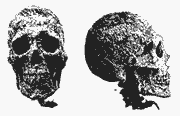
|
|
|
Lovelock Cave skull discovered in the 1920s in Lovelock, Colorado. The mummies were ignored by the local authorities and ordered to be
reburied. Some skulls had red hair, which occurs only in Europeans, proving that there was a European presence in the Americas before Columbus.
Image from
Runestone.org.
|
|
The Si-Te-Cah were another mysterious tribe of giants whose origin had been previously unexplained. Not merely tall, these giants also had red hair, and mummified their dead. They were also a warlike, cannibalistic people who were in a constant state of war with the other, Asiatic tribes, who harassed them constantly. Eventually, with the concerted efforts of several tribes, the Si-Te-Cah were pushed back to their homelands in the area around Mt. Shasta. And it was there, in a cave, that they met their fate. As McNatten explains,
So how did the mummies get in the cave, anyway? The way the Paiutes tell it, the Si-Te-Cah lived on a lake in the basin overlooked by the cave. When I say on the lake, that's just what I mean - they dwelled on rafts to escape harassment from the Paiutes. The rafts, like many other things in Si-Te-Cah society, were made of a fibrous water plant called tule; in fact, the name Si-Te-Cah means "tule eaters."
The Paiutes and the long-legged redheads did not get along well. The Indians accused the Si-Te-Cah of being cannibals, and waged war against them. The Si-Te-Cah fought back. After a long struggle, a coalition of tribes trapped the remaining Si-Te-Cah in what is now called Lovelock Cave. When they refused to come out, the Indians piled brush before the cave mouth and set it aflame. The Si-Te-Cah were annihilated.36
In 1911, guano miners digging in a cave in Lovelock, Nevada found in the excrement a collection of mummies, bones and artifacts. True to the tale, the mummies were indeed red-headed. Other red-headed mummies were found in other parts of the same region as well, including the Humboldt Lake bed and a local ranch. However, once again, the scientific establishment ignored the evidence, and the Lovelock mummies remain a mystery to this day. Interestingly, as we saw in our summer, 2002 story on
Mt. Shasta,
the
Modoc
of the Shasta area believed that they were actually the descendants of the intermarriage between a red-headed people and a more primitive form of human. Perhaps the final fate of the Si-Te-Cah was not, in fact, death by fire, but by gradual integration, as was the eventual fate of all of the giant invaders of the Americas.

Though there are only a few stories about major tribes of giants in Native American lore, other unusual giant stories do occur from time to time in the histories of the various Native American tribes. Even after the destruction of the major tribes of giants in the Ohio Valley, giants occasionally visited the Native Americans, and even left positive impressions on their lesser hosts, as one native storyteller relates:
James Wafford, of the western
Cherokee,
who was born in Georgia in 1806, says that his grandmother, who must have been born about the middle of the last century, told him that she had heard from the old people that long before her time a party of giants had once come to visit the Cherokee. They were nearly twice as tall as common men, and had their eyes set slanting in their heads, so that the Cherokee called them Tsunil� kalu�, "the Slant-eyed people," because they looked like the giant hunter Tsul� kalu�. They said that these giants lived far away in the direction in which the sun goes down. The Cherokee received them as friends, and they stayed some time, and then returned to their home in the west....37
Interestingly, their namesake, Tsul 'Kalu, which means "slanting eyes", was also a war and
thunder god.
The Cherokee religion also has a pair of twins that they called the "Thunder-boys". This is very similar to the Indo-Europeans, whose primary deities were war and thunder gods. Also, as we have seen, twins figured prominently in their pantheon of gods as well, as they also did in Central and South America.

Rumors and reports of giants in Central and South America are no less numerous than those of North America. However, though there are seemingly endless lists of archaeological and historical reports of both living giants and giant remains throughout the Americas, we will focus on the most prominent of these giant sightings for this work, and direct the reader to the list of resources at the end of this article for further research on the voluminous amount of archaeological and historical evidence for the existence of giants in the Americas.
It is not known whether or not the Indo-Aryan Kurgans penetrated as far south as Central and South America. The
genetic testing
taken on North American Indians was not performed on the natives of the Central and South American nations, so genetic evidence of a Kurgan invasion south of the present United States is not currently available. However, the ancients did not respect modern boundaries, roaming and conquering at will throughout the Americas, so we could, and should, expect to find giants all the way down to the very southern tip of Argentina. And, in fact, we do.

The "Tsunil Kalu" that had visited the Cherokee in ancient times had come from a land far in the west. The Cherokee had lived in the American southeast in ancient times, so the Tsunil Kalu likely came from the American southwest. The southwest, as we have seen, was one of the places that the Na-Dene language, a derivative of Dene-Caucasian, is still spoken today. This forms a linguistic link between central Asia and North America, and thus helps prove our Kurgan Invasion theory, because Central Asia is where the Dene-Causasian family of languages comes from.
|
|
|
|
|
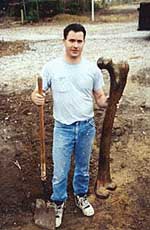
|
|
|
A giant femur (thigh) bone found reportedly found in Turkey. Assuming this find is legitimate, the owner of this bone would have been
close to 20 feet tall, comparable to some of the ancient reports of giant bones found in Mexico.
Image from
S8int.com.
|
America's desert southwest is a contiguous region that reaches well into Mexico, so it is likely that the Tsunil Kalu were either from or related to other giants who lived in Mexico. However, since we do not have genetic evidence from south of the border, we must look to the histories of the early explorers and from the Native Central Americans themselves to find clues as to whether or not giants indeed inhabited Central America. Fortunately, there is a great deal of historical — and archaeological — evidence that clearly indicates that Central America once hosted substantial populations of giants.
Steve Quayle gives a good summary of the types of giants and giant remains that have been found in central America, particularly Mexico, citing several instances where Spanish conquistadores encountered both giant remains and living giants during their forays into what is now Central America:
The fossil bones of Mexico are often referred to by those now inhabiting the area as being from the giants who dwelt in the land in early times. According to the local legends, these giants lived in the plains of Tlascala by the Olmecs, who came there before the Toltecs. At the time of the Spanish Conquest,
Bernal Diaz
was told of the huge stature of these giants as well as their crimes; and, to show him how big they were, the storytellers brought him a bone of one of them, which he measured himself against, and it was as tall as he, who was a man of reasonable stature. He and his companions were astonished to see those bones, and held it for certain that there had been giants in that land.38
Bernal D�az del Castillo was one of the chief chroniclers of the conquest of Mexico by the Spaniards. He spent his first years in the Americas as a soldier helping to conquer Mexico, and in the process, he learned a great deal about the history of the area, particularly about the
Aztecs.

|
|
|

|
|
|
Tenochtitlan, now Mexico City, was the capitol of the Aztecs. Tenochtitlan was a magnificent city, as or more magnificent than any other city in the world, and was of such a grand scale, some believe that it could only have been built by giants.
Image from
Hope of Israel Ministries.
|
|
The Aztecs were a native American people who dominated northern Mexico during the time of the
Spanish Conquest of Mexico, in the early 1500s. They had originally lived in the desert southwest, but had fled south, into modern-day Mexico, to escape the oppressive taxes of the
Toltecs, who apparently still held control over at least part of the desert southwest. From this migration came the legend of
Aztalan, a land of many waters somewhere to the north of Mexico, where the ancestors of modern Mexicans had emigrated from.
According to their own legends, they originated from a place called Aztlan, somewhere in north or northwest Mexico. At that time the Aztecs (who referred to themselves as the Mexica or Tenochca) were a small, nomadic, Nahuatl-speaking aggregation of tribal peoples living on the margins of civilized Mesoamerica. Sometime in the 12th century they embarked on a period of wandering and in the 13th century settled in the central basin of M�xico. Continually dislodged by the small city-states that fought one another in shifting alliances, the Aztecs finally found refuge on small islands in Lake Texcoco where, in 1325, they founded the town of Tenochtitlan (modern-day Mexico City). The term Aztec, originally associated with the migrant Mexica, is today a collective term, applied to all the peoples linked by trade, custom, religion, and language to these founders.
Fearless warriors and pragmatic builders, the Aztecs created an empire during the 15th century that was surpassed in size in the Americas only by that of the Incas in Peru.39
|
|
|
|
|
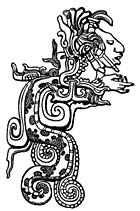
|
|
|
Quetzalcoatl, the chief god of the ancient Mexicans, was believed to be a red-haired, Caucasian giant who wore a white tunic
covered with red crosses. He originally came to Central America from the east, across the sea, and promised to return again in the future.
|
The Aztecs believed that their chief god
Quetzalcoatl
was a giant, bearded Caucasian who had come to Mexico in ancient times and had taught
the cultural predecessors of the Aztecs
all aspects of civilization, including but not limited to the following:
 Named all of the landmarks of the Earth (mountains, seas, etc.)
Named all of the landmarks of the Earth (mountains, seas, etc.)
 Discovered maize
Discovered maize
 Created fire (in the guise of Mixcoatl)
Created fire (in the guise of Mixcoatl)
 Established the maguey culture -- octli brewing and ceremonial drunkenness
Established the maguey culture -- octli brewing and ceremonial drunkenness
 Gave instruction of music and dance
Gave instruction of music and dance
 Cured eye ailments, blindness, coughs, skin afflictions;
Cured eye ailments, blindness, coughs, skin afflictions;
 Gave the priests the practice of curandero, the diagnostic casting of lots (a sort of medical divination)
Gave the priests the practice of curandero, the diagnostic casting of lots (a sort of medical divination)
 Helped with fertility problems
Helped with fertility problems
 Sired royal lineages
Sired royal lineages
 Established the priesthood -- gave proper instruction of sacrifice and created the Tonalmatal (Book of the Destiny Days)
Established the priesthood -- gave proper instruction of sacrifice and created the Tonalmatal (Book of the Destiny Days)
 Domesticated animals40
Domesticated animals40
However, despite all the aid he had given the ancient Mexicans,
Quetzalcoatl
had been driven away by an evil priest named
Tezcatlipoca,
and had headed east, back to his homeland across the sea. He was prophesied to return again at some point in the future, however, to help check on the progress of the ancient Mexican peoples whom he had helped civilize. Interestingly, in the same year that it was believed that this light-skinned, bearded giant from the east was prophecied to return, the light-skinned, bearded
Hernan Cortez
met with the Aztecs for the first time. Another interesting fact is that the Aztecs also believed that Quetzalcoatl's robes had been white, covered with red crosses, a uniform very similar to that worn by Cortez and his men.41
Another scholar by the name of Fray Diego Duran had an opportunity during the time of DeSoto's and Coronado's conquests to preach to the natives, and in the process, learned a great deal about their history. Duran learned that in ancient times, Mexico had belonged to a mixture of giants and a primitive people of average size. Around 900 a.d., however, six tribes from North America had emigrated to Mexico, and had destroyed the savage, abominable giants and taken their land. One historian believed that these giants had been the same people as the
Toltecs,
who had built the massive city of Teotihuacan. Upon finding one of their skeletons, another historian described the teeth as nearly as big as the fist of a man.42 Interestingly, the capitol city of the Toltecs was
Tula,
perhaps the same Tula after which the red-headed, giant
Si-Te-Cah,
mentioned previously, had been named, the name Si-Te-Cah meaning "tule eaters". The Si-Te-Cah had actually been chased out of the area that is now
Lovelock, Nevada
in southern Nevada. The city of Tula was in northern Mexico, only a few hundred miles away from Nevada. Thus, it may be that the Toltecs and the Si-Te-Cah may have been related, even the same, people.

The Aztecs myths and legends still tell the story of Caucasian giants who visited them from the east via boats. The Aztecs also believed that Quetzalcoatl, one of the "white giants", had left behind a royal lineage of Caucasian/Mexican descent. This was also true of the Maya, who believed that their kings were half god and half human, and were occasionally pictured with six fingers and six toes. Six fingers and toes, as we have seen, was one of the hallmarks of the giants. Interestingly, like the Kurgans, the Maya also worshiped twin gods, called Hunapu and Xbalanque.43
The Maya were the cultural predecessors of the Aztecs in the region, and the Aztecs received much of their beliefs and traditions from the Maya, (as well as other cultures such as the Toltecs). They may have also intermarried to some extent.
The Maya may have been visited, or even conquered by the same race of "red-bearded" Indo-European giants that had conquered North America in the ancient past, the existence of a dynasty of six-digited rulers and the worship of twin deities being the only remaining evidence of that ancient conquest.

Ecuador, which occupies the farthest western coast of South America, has perhaps some of the most terrifying tales of the most wicked giants. As Quayle explains,
At first the Spaniards thought that the natives in Guayaquil, Ecuador, were fabricating a tale concerning a tribe of giants who once invaded their land and terrified them for some years. But they spoke so convincingly about such a time that, in 1543, Juan de Olmos, lieutenant governor of Port Viejo, finally ordered excavations be made in the valley at the place where the natives claimed these giants were destroyed by fire from heaven. In the his account of these archaeological diggings, Zarate reported that Olmos' party "...found such large ribs and other bones that, if the skulls had not appeared at the same time, it would not have been credible they were of human persons.... Teeth then found were sent to different parts of Peru; they were three fingers broad and four in length." They also found marks from thunderbolts in the rocks there, giving further credibility to the story the natives told.44
In very ancient times, a tribe of giants had invaded South America along the western coastline as far as Ecuador. According to the legend, these giants were so wicked that they had actually been destroyed by fire from heaven. This of course, as we saw in
Part I,
was the same fate of the giants of Sodom, and for the same reasons, as we shall see.
|
|
|
|
|
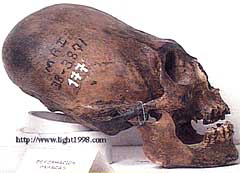
|
|
|
A giant skull from the Gold Museum in Lima, Peru. The shape of the skull would explain the description of the "misshapen" heads of the giants given by the Ecuadorian natives.
Image from
Light 1998
|
"The natives tell, from what they heard through their forefathers, who heard and had it from far back, that there came by sea in rafts of reeds after the manner of large boats, some men who were so tall that from the knee down they were as big as the full length of an ordinary fair-sized man, and the limbs were in proportion to their bodies, so misshapen that it was monstrous to look at their heads, as large as they were, and with the hair that came down to the shoulders. The eyes they give to understand were of the size of small plates. They affirm that they had no beards and that some were clad in skins of animals, while others came as nature made them, and there were no women along.... These tall men or giants ... ate and wasted all the food they could find in the land, for each one of them consumed more than fifty of the natives of the country, and as the supply was not sufficient for them, they killed much fish in the sea by means of their nets and contrivances which, it stands to reason, they must have had."45
If the legend is to be believed, these giants appear to have been close to 20 feet tall. Moreover, their proportions were huge and their appearance gruesome to behold, as if they had stepped out of a horror film. Not handsome as the giants of Europe were said to be, these giants were fearsome to behold, their glaring eyes and massive, misshapen heads causing fear and revulsion in all who saw them. Interestingly, just as the giants of the ancient Near East were described,
they wasted resources,
consuming mass quantities and giving no thought to conservation of resources to enable their continued usage. Little more than giant human parasites, these foul creatures were a menace to society, and to themselves, fouling and destroying everything they touched.
"The natives abhorred them, for they killed their women in making use of them, and the men they killed for other reasons. The Indians did not feel strong enough to kill these new people that had come to take their country and domain, although great meetings were held to confer about it; but they dared not attack them. After a few years, the giants still being in the country, and having no women, and those of the Indians not suiting their great size, or because it may have been by advice and inducement of the demon, they resorted to the unnatural vice of sodomy, which they committed openly in public, with no fear of God and little shame of themselves." Cieza then wrote that, according to the account handed down by the natives, an angel in a mass of fire descended from heaven and killed the giants.46
This conquest model was probably normative for the Kurgan giants. Traveling along the shoreline in shallow-draft boats gave them easy access to any part of the coast, allowing them to move quickly and strike hard without having to fight their way through the land. Normally the womenfolk would follow the men on land in horse-drawn carts, perhaps with the intent of appearing to be traders rather than conquerors, but this time the women had not been able to follow. As a result, those giants that were not destroyed by the angel died out or were assimilated into the local populations, but not without first doing terrific damage to the natives and their environment.

Though there are no known living giants in Ecuador, there is a tribe of normal-sized people that has some among them that exhibit giant characteristics, such as six fingers, six toes, and double dentition. They are a tribe of particularly violent South American aborigines called
the Waorani.
The Waorani were first discovered in the 1940s when they attacked and killed an expedition looking for oil. "By 1949, a total of twelve Shell employees had been killed by Waorani, forcing Shell to abandon their operations. The Waorani had earned a reputation as a tribe of hostile 'savages', or in the Quichua language, 'Aucas'. It would be almost another decade before any peaceful contact would be made."47
This next contact would come in the form of the Christian missionary
Jim Elliott.
Unfortunately, Elliott and four other missionaries were killed by the vicious Waorani, but later missions by Elliott's widowed wife proved to be successful in breaking the cycle of violence and civilizing the Waorani.48
During the 1970s, one Dr. James Yost had made substantial efforts to learn more about these mysterious people and their unknown origins. In the process, Yost found some facts about the Waorani that were disturbing:
Unravelling the secrets of Waorani culture, Jim made some amazing discoveries. He found that the Waorani had maintained the highest levels of homicide ever recorded in the annals of human history. Fully fifty per cent of all deaths in the preceding five generations had been the result of homicide as the Waorani engaged in a continuous and deadly internal vendetta, pursued mostly at night, in spearing raids. No death, it seemed, whatever the cause, went unavenged. Furthermore, the Waorani were even reputed to kill by spearing any, although only a few instances have been proven, of their old people who no longer had the means to support themselves; and they practised infanticide, either strangling unwanted or malformed babies with vines, or burying them alive.49
The Waorani, though extremely violent, also exhibited superior genetics, being some of the healthiest people in the world: "Medically, the Waorani turned out to be something of an enigma: they had no trace of cancer; no cardiovascular disease; no high blood pressure; no allergies; and none of the known diseases familiar to us."50 Not only were they physically superior in many ways, some even had six fingers on each hand and six toes on each foot — characteristics, as we have seen, of the giants. It would appear that the giants of old that had invaded Ecuador, as described previously, had integrated with the native Asiatic population, creating a hybrid race of people that were in many ways physically superior — and extremely violent.


|
|
|
The "Lord of Sipan" absolute ruler of the Moche around 300 a.d., and considered to be half-god, half-man by his subjects.
Image from
MachuPicchuTravel.com
|
|
Just to the south of Ecuador on the western coast of South America lies Peru.
The earliest known inhabitants of Peru were the
Chavin
people, about whom little is known save from some religious artifacts. The Chavin culture had its early beginnings around 1400 b.c., and began to go into decline around 300 a.d., where it was gradually replaced by the
Moche
culture. The
Moche,
were a fairly sophisticated culture, the most prominent of whom appears to have been one
"Lord of Sipan",
who appears to have been one of the great kings of the ancient world, even considered to be
half god, half man
by his subjects. The Lord of Sipan, who lived around 300 b.c., had been buried with
treasures
so rich and extensive that he has been called the Tutankhamun of pre-Columbian America. Another prominent archaeological treasure of ancient Peru during the Moche period are the so-called
Nazca lines,
the origin and function of which are still not clear to this day.
The Moche, who formed the cultural basis from which all later South American civilizations would grow until the Spanish conquest, were in turn abruptly supplanted by the
Chimu
culture around 1100 a.d., and lasted until the 1400s, when they were in turn replaced by the Inca, perhaps the best known of all South American civilizations.

Though the Incan empire had only been around for a few centuries before they were destroyed by the
Spanish
under Pizarro, the
Inca
are the best known culture of South America. And in that short space of time, they created cultural and architectural achievements that were nothing short of astounding.
|
|
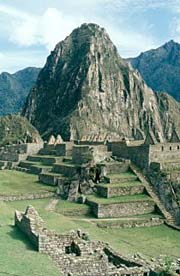
|
|
|
Machu Picchu,
located in the Andes Mountains in Peru, northwest of Cuzco.
|
Between 1200 and 1535 AD, the Inca population lived in the part of South America extending from the Equator to the Pacific coast of Chile. The beginning of the Inca rule started with the conquest of the Moche Culture in Peru. The Inca were warriors with a strong and powerful army. Because of the fierceness of their army and their hierarchical organization, they became the largest Native American society. The height of their reign in the 15th century came to a brutal end in 1535 when the Spanish conquistadors took over their territory.
Their cities and fortresses were mostly built on highlands and on the steep slopes of the Andes Mountains. The architecture of the Inca cities still amazes and puzzles most scientists. Stone steps lead up to the top of the cities, which consist of stone houses and religious buildings. The blocks of stones weigh several tons and they are fit together so tightly that not even a razor blade can fit through them.51
The Inca cities such as Machu Picchu were so massively built and the megalithic stones so large, some of them weighing hundreds of tons, that only giants could have built them. And displayed in the
Gold Museum
in Lima, Peru, are in fact the
ancient giant skulls of rulers,
proving that giants did indeed walk the earth, at least in Peru.
Glenn Kimball
also describes a tour he was given of a collector's private museum wherein were displayed 9-10 foot-tall Incan mummies wearing clothing made of spun gold:
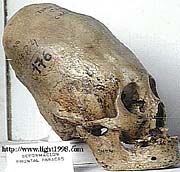
|
|
|
A "long-headed" giant skull from the Gold Museum in Lima, Peru. Note that the skull is gigantic in size, and the shape is natural —
not a result of cradleboarding. That practice was likely adopted by Native Americans to imitate the ancient giant rulers of old.
|
|
Nine-and-a-half feet tall is large for a human mummy, especially when it is found among today's diminutive Peruvians, whose average stature is just five feet. Understandably, professional anthropologists find tales of ancient giants amusing, but nothing more. Physical evidence may nonetheless exist to demonstrate that an oversized race of men did indeed dominate parts of prehistoric South America.
The actual mummified head of the crowned king in the photograph is almost twice as large as my own and I wear the largest hat of anyone in my acquaintance. When we were invited to the private gold museum to begin with I was expected to be dazzled by gold. However, it dawned on me the minute I walked through the door that the size of the head, and indeed his whole body, was the unique feature of this king. The gold was impressive, but the size of the man was something more impressive than gold.
The golden tunic that hung on the wall was made of spun gold. This was the first time in my life I had seen gold woven into a fabric for clothing. The tunic was over eight feet tall and tailored in such a way as to suggest that it was not intended to drag on the floor behind a king, but rather to hang straight down to the floor and no further. That made the tunic itself a measuring device for the original height of the giant king. It was shocking to imagine a man who could first wear this tunic without looking like a small child playing with his mother's clothing and secondly it was shocking to imagine the shear weight of the garment. The golden necklace at the foot of the tunic would have hung to the floor around the neck of anyone I know. The golden shoulder shield in the photograph was almost twice the size of shoulder pads used by professional football players.
There was also a set of golden gloves whose hands and fingers extended from the wrist to the tip of the middle finger about twelve to fourteen inches. I couldn't tell exactly because they were kept behind security glass.52
And not only were there
giant Inca kings
in Peru, there were also
pyramids
and
red-headed mummies.
These mummies were of a royal line, descended from
Viracocha,
a red-bearded, Caucasian demigod very similar to the Quetzalcoatl of the ancient Aztecs:
|
|
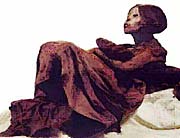
|
|
|
A Peruvian red-headed mummy. This mummy was apparently one of the last of the line of Viracocha, the Caucasian founder of South American civilization. Image from
BUFO Radio
|
Some of the mummies were found to have the stiff black hair of the Indians, while others, which have been kept in the same conditions, have red, often chestnut-colored hair, "silky and wavy, as found amongst Europeans, they have long skulls and remarkably tall bodies. Hair experts have shown by microscopic analysis, that the red hair has all the characteristics that ordinarily distinguish a Nordic hair type from that of Mongols or American Indians."
Pizarro asked who the white skinned redheads were. The Inca Indians replied that they were the last descendants of the Viracochas. The Viracochas, they said, were a divine race of White men with beards. They were so like the Spanish that the Europeans were called Viracochas the moment they came to the Inca Empire. The Incas thought they were the Viracochas who had come sailing back across the Pacific.53
The existence of gigantic skulls, red-headed mummies, and recollections of giant, Caucasian visitors in ancient times who brought civilization, makes it clear that the Indo-Europeans may have made it as far down south as Peru. But did they stop there?

Previously we had hypothesized that the Indo-Aryan Kurgans were the same "sea peoples" who had invaded ancient Canaan during the second millennium b.c. More recently we saw that the ancient giants of Ecuador also had invaded Ecuador from the sea. It is reasonable to assume, then, that the Kurgan invasion pattern may have been largely sea-based. If so, we could expect to find even more stories of giants further down the west coast of South America from Ecuador and Peru, even stretching around the horn of South America. And indeed, we do.
In 1520, when Magellan was looking for a pass to run around the horn of South America and into the Pacific Ocean in his attempt to circumnavigate the world, he ran into a snow storm so severe that he was forced to take anchor in the
Bay of San Julian
on the east coast of modern
Argentina.
Fearful of a mutiny due to fear of the weather and low food reserves, Magellan decided to stay ashore for a time and initiate repairs as well as build up their food stores. Weeks and months passed uneventfully until one day Magellan and his crew saw something quite unusual. As Magellan's chronicler explains in his Journals,
We had been two whole months in this harbor without sighting anyone when one day (quite without warning) we saw on the shore a huge giant, who was naked, and who danced, leaped and sang, all the while throwing sand and dust on his head. Our Captain ordered one of the crew to walk towards him, telling this man also to dance, leap and sing as a sign of friendship. This he did, and led the giant to a place by the shore where the Captain was waiting. And when the giant saw us, he marveled and was afraid, and pointed to the sky believing we came from heaven. He was so tall that even the largest of us came only to midway between his waist and his shoulder; yet withall he was well proportioned. He had a large face, painted round with red; his eyes were ringed with yellow and in the middle of his cheeks were painted two hearts. He had hardly any hair on his head, what little he had being painted white.54

The name of this tribe of Indians was the Tehuelches, but initially Magellan named them "Patagonians", after the Spanish word patagon,
or "big feet". This was because their feet were unusually large even for their size. They also wore musical rattles around their waists, so when they danced, they gave off a tremendous musical noise, which they danced to like madmen. Dancing and capering, laughing and throwing dust up over their heads, with their fancy, musical costumes, big feet, and oddly painted faces, the Patagonians must have looked like clowns to the Spanish explorers. And not only were they like clowns, they also had enormous appetites, able to eat at one sitting enough biscuits to feed 20 Spaniards.
Though the existence of the Patagonian giants is now doubted by most mainstream scholarship, their existence was not doubted by the explorers and people of the time, who often went out of their way to see a Patagonian giant.
Like North America, Central and South America were full of giants, from the equator all the way down to the horn of South America. These giants were gradually killed off or outcompeted for resources by the smaller but more numerous Asiatics, the remnants of these giant tribes eventually intermarrying with them, creating a breed of taller Central and South American Indians. Some of these natives were aristocracies like those found in Europe and Asia, being taller, fairer of skin, and often having red or blonde hair, clearly linking them to Europe. Moreover, the histories of Central and South America make it clear that giants had once ruled over North, Central and South America.

Having initially embarked on a simple survey of the evidence pointing towards the existence of giants in the Americas in ancient times, we have instead gone a giant step further and developed a radical new theory about the origins and history of humanity not only in the Americas, but throughout the world. The basis of this theory has been formed on significant evidence of a major migration of a warlike people that took place during the second millennium b.c. This migration started in Central Asia, and the peoples who undertook the migration were called the Kurgans. These Kurgans were very large in stature, ranging from 7-9 feet tall, some of them being gigantic, reaching up to 12 feet tall or taller. The symbol of the Kurgans was the swastika, which was a symbol of the sun, the four winds and, above all, conquest, which they undertook on all fronts — north, south, east and west. Their conquests north and south were limited in success, but their eastern and western campaigns were highly successful, both reaching all the way to the Americas. When they had met in the Americas, however, they made war on each other, the western front overcoming those who had gone east. Eventually, through wars and assimilation with the smaller local inhabitants, both the northern, southern, eastern and western campaigns of Kurgan giants finally petered out. Having been gradually worn down and absorbed by the smaller but more numerous homo sapiens, both the blonde, Caucasian giants and the smaller, dark-haired homo sapiens intermarried, the end result of the war of the giants being a larger, stronger homo sapiens, many of whom now have lighter skin, blonde, and even red hair. Linkage was also made with the giants of the ancient Near East, and additional evidence added to our theory about how the giants originally had been created by "higher powers" as a means through which they could conquer the world. Further speculation was added about how World War II may have been started by these fallen angels trying yet again to recreate the ancient giants of old and conquer the world, and how future world wars may be started with the same goals in mind.
Now, as a result of the victory of lowly homo sapiens over the giants, only their giant footsteps in history remain in the form of their history, religion, language and culture, all of which are still remembered by the inhabitants of the Americas — memories that were still relatively fresh by the time that the first Christian explorers came to the New World. Moreover, discoveries of giant bones by these explorers, discoveries that have taken place as recently as the twentieth century, continue to prove that giants did indeed walk the Americas. The question lies now in the hands of the academic establishment. Will they continue to willfully neglect the genetic, linguistic, cultural, archaeological and historical evidence, maintaining the failed Isolationist paradigm in the face of overwhelming evidence, or will they risk the reprisal of
Mammon
by stepping out and revealing the evidence of America's true history that has lain buried in obscurity for over a century? Is it truly science if one willingly covers up evidence that only contradicts one's cherished beliefs? Have academics been reduced to the level of having to cover up the truth in order to save their careers?
One has to wonder if the theories one hears about sinister forces working behind the scenes are indeed true, forces that wish to control us by covering up vital information about our true history. Increasingly more and more people are coming to the conclusion that we are being held in bondage to a false history, but are afraid to speak out lest we be chastised for political incorrectness, crippled by social sanctions, or worse. Yet, these questions need to be answered before we can truly know who we are and why we are here.
We may even find that the quest to find these answers may lead us to the conclusion that our history has all been part of a
"great game"
— a "game" or, more accurately, "war",
that has been controlling the destiny of mankind since its beginning. However, this war is fought primarily with neither weapons, words, nor even ideas, but with
genetics,
where man himself is the weapon, and the hearts of men, the battlefield.
There were giants in the Earth in those days ... and also afterwards. 




|
|
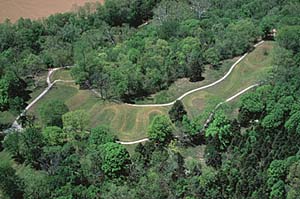
|
|
Serpent Mound, located near Peebles, Ohio in the heart of the Ohio Valley, sat at the center of giantkind in North American
prehistory.
|
If one has the daring to actually search for evidence of America's giant past, one should begin in the heartland of giantkind in the Americas: the Ohio Valley, home of the
Great Serpent Mound.
However, if you are lucky enough to find evidence of giants, whether a complete skeleton, bones, artifacts, or other unusually large or Kurgan-oriented artifacts, do not attempt to excavate them yourself — irreplacable information may be lost if the excavation is not carried out professionally. Contact us directly at
publisher@mysteriousworld.com
and we will contact a professional archaeologist to do the job for you (and give you the credit for the find).
Regardless of whether or not you actually find any giants, you may find that the real fun is in the search. Consult these links for a guide to see where giants are most likely to be found in the Americas. Make sure to note the travel advisory links from the State Department as well:

 Serpent Mound/Ohio Valley links (The Adena, Alleghans, Ronnongwetowanca)
Serpent Mound/Ohio Valley links (The Adena, Alleghans, Ronnongwetowanca)
 Mt. Shasta links (The Si-Te-Cah)
Mt. Shasta links (The Si-Te-Cah)
 The American Southwest (The Tsunil Kalu)
The American Southwest (The Tsunil Kalu)
 Side Canyon ... explore the American Southwest
Side Canyon ... explore the American Southwest
 The Grand Circle
The Grand Circle
 SouthwestDirectory.com
SouthwestDirectory.com
 Southwest Vacation Travel
Southwest Vacation Travel
 Sierra Heritage
Sierra Heritage


 U.S. Department of State: Mexico
U.S. Department of State: Mexico
 Mexico.com
Mexico.com
 Si-Mexico
Si-Mexico
 Know Mexico
Know Mexico
 Andale Mexico
Andale Mexico
 Mexico Online
Mexico Online
 Traveler's Health: Central America
Traveler's Health: Central America

 U.S. Department of State: Ecuador
U.S. Department of State: Ecuador
 Columbus Guides: Ecuador
Columbus Guides: Ecuador
 Ecuador.com
Ecuador.com
 EcuadorSpecial.net
EcuadorSpecial.net
 EcuadorExplorer.com
EcuadorExplorer.com
 Explorering Ecuador
Explorering Ecuador
 Explorering Ecuador
Explorering Ecuador
 Ecuador Travel Guide
Ecuador Travel Guide
 HotelsTravel.com: Ecuador
HotelsTravel.com: Ecuador

 U.S. Department of State: Peru
U.S. Department of State: Peru
 Kontiki Tours & Travel: Peru & Machu Picchu
Kontiki Tours & Travel: Peru & Machu Picchu
 Enjoy Peru
Enjoy Peru
 ancientperu.com
ancientperu.com
 GORP: Ancient Peru
GORP: Ancient Peru
 Tropical Nature Travel: Peru
Tropical Nature Travel: Peru
 Machu Picchu: Crown Jewel in the Clouds
Machu Picchu: Crown Jewel in the Clouds

 U.S. Department of State: Argentina (Patagonia)
U.S. Department of State: Argentina (Patagonia)
 Argentina Discover
Argentina Discover
 Patagonia Argentina & Chile Travel Guide
Patagonia Argentina & Chile Travel Guide
 iExplore: Patagonia
iExplore: Patagonia
 Patagonia-Argentina.com
Patagonia-Argentina.com
 Patagonia Travel Guide
Patagonia Travel Guide
 interpatagonia.com
interpatagonia.com
 Southwind: Patagonia Nature Discovery
Southwind: Patagonia Nature Discovery
 Visit Chile: Chilean Patagonia
Visit Chile: Chilean Patagonia
 Victory Cruises: Patagonia
Victory Cruises: Patagonia
 |
|
|
Part I: Giants of the ANE
|
Part III: Giants of Asia
|
Part IV: Giants of Europe
The Holocaust of Giants
|
Giant Characteristics
|
Giants of North America
Giants of Central & South America
|
Conclusions
|
Hunting for Giants
Giant Links
|
Giant Books
|
Audio
|
Video
|
Posters
Editorial
|
Press Releases
|
Book Reviews
|
Fragments
Serpent Mound II
|
Giants II
|
Osiria II
Register
for our new Hall of Records Newsletter!
Questions? Comments? Suggestions? Advertising? Press Releases?
Contact us!

1
Ross Hamilton, "Holocaust of Giants: The Great Smithsonian Cover-up"
(Serpent Mound Mysteries: http://greatserpentmound.org).
2
Hamilton, "Holocaust of Giants".
3
"The History of the Smithsonian"
(Smithsonian: http://www.smithsonian.org).
4
Hamilton, "Holocaust of Giants".
5
Patrick Cooke, "A Giant Cover-up:
The Smithsonian Giants"
(The Bible UFO Connection: http://www.bibleufo.com).
6
Venice Florida dot com,
"Sharks' Teeth General Info"
(Venice Florida! dot com: http://www.veniceflorida.com).
7
Mary Sutherland,
"Was There a Race of People that Had Horns?"
(BUFO Radio: http://www.burlingtonnews.net).
8
Steve Quayle,
"Accounts of Giants in North America: Ohio Giants"
(The Q Files: http://www.stevequayle.com).
9
Richard L. Dieterle,
"Giants or Man Eaters (W�ger�tcge)"
(The Encyclopedia of Hotc�k (Winnebago) Mythology: http://hotcakencyclopedia.com).
10
The Thunderbirds were primarily benificent spirits, but apparently some of them had turned bad. For more information on the native American Thunderbird myth, see our popular article,
"The Fabulous Thunderbird".
11
Dieterle,
"Giants or Man Eaters (W�ger�tcge).
12
Claessen, D., A de Roos and L. Persson,
"Giant cannibals emerge from size-structured population dynamics [Abstract]"
(Allen Press Abstracts: http://abstracts.allenpress.com).
13
George Noory and Steve Quayle,
"Dead Scientists"
(Coast to Coast A.M.: http://www.coasttocoastam.com, Broadcast Date: 11/27/2003).
14
Edwin Black,
"Hitler made eugenics famous,
but he took it from United States"
(JTA: Global News Service of the Jewish People: http://www.jta.org).
15
Black,
"Hitler made eugenics famous,
but he took it from United States".
16
C.A.N.D.L.E.S. Web Museum,
"Mengele"
(C.A.N.D.L.E.S. Web Museum: http://www.candles-museum.com).
17
NationMaster.com,
"Aryan"
(NationMaster.com: http://www.nationmaster.com).
18
Sarah Boxer,
"Move afoot to detoxify ancient, once-benign swastika symbol"
(Seattle Post-Intelligencer: http://seattlepi.nwsource.com).
19
NationMaster.com,
"Aryan Race"
(NationMaster.com: http://www.nationmaster.com).
20
University of Calgary,
"Kurgan Culture"
(University of Calgary: http://www.ucalgary.ca).
21
Koenraad Elst,
"Where Did the Kurgans Come From?" in
Update on the Aryan Invasion Update
(South Asia Books: 1999).
22
Free Papers,
"The Aboriginal People of Newfoundland"
(Free Papers: http://www.freepapers.net).
23
Luigi Luca Cavalli-Sforza,
Genes, Peoples, and Languages
(Berkeley: University of California Press, 2000), 135, 158, 169.
24
David Larkin and Julek Heller,
Giants
(New York: Harry N. Abrams, 1985), 40-41.
The Indian tribe referred to here is likely the
Pawnee.
25
Greg Little, John Van Auken and Lora Little,
Mound Builders: Edgar Cayce's Forgotten Record of Ancient America
(New York: Harry N. Abrams, 1985), 60.
26
Hamilton, "Holocaust of Giants".
27
University of Calgary,
"The Legend of Gog and Magog"
(University of Calgary: http://www.ucalgary.ca).
28
Academy for Ancient Texts,
"The Book of Enoch: Book 1: Watchers"
(Academy for Ancient Texts: http://www.ancienttexts.org).
29
Dieterle,
"Giants or Man Eaters (W�ger�tcge)". Interestingly, there is a legend of the
Thunderbird
where the home of the Thunderbirds lies beyond two great, magical mountain peaks that open and close together like a gate, similar to that described in the Alexandrian myth of Gog and Magog. Could the Thunderbird myth have been a remnant of the ancient Indo-European beliefs that remained as a fragment of Native American tradition?
30
Dieterle,
"Giants or Man Eaters (W�ger�tcge)".
31
Robert Silverberg,
The Mound Builders
(Athens, OH: Ohio University Press, 1968), 194-195.
32
Ross Hamilton, "A Tradition of Giants"
(Serpent Mound Mysteries: http://greatserpentmound.org).
33
Steve Quayle, "A Tradition of Giants and Ancient North American Warfare, Part 2"
(The Q Files: http://www.stevequayle.com).
34
Quayle, "A Tradition of Giants and Ancient North American Warfare, Part 2".
35
Quayle, "A Tradition of Giants and Ancient North American Warfare, Part 2".
36
Steve McNatten, "Who Were the Si-Te-Cah?"
(Runestone.org: http://www.runestone.org).
37
Mary Sutherland, "Giants of Ohio and the Mound Builders"
(BUFO Radio: http://www.burlingtonnews.net).
38
Steve Quayle, Genesis 6 Giants
(Bozeman, MT: End Time Thunder Publishers, 2002), 197.
39
Glenn Welker, "The Aztecs/Mexicas"
(Indians.org: http://www.indians.org/).
40
USCD, "Quetzalcoatl the Myth"
(University of California, San Diego: http://weber.ucsd.edu/).
41
Quayle, Genesis 6 Giants, 205-206.
42
Quayle, Genesis 6 Giants, 272-273.
43
Quayle, Genesis 6 Giants, 200-201.
44
Quayle, Genesis 6 Giants, 284.
45
Quayle, Genesis 6 Giants, 284-285.
46
Quayle, Genesis 6 Giants, 285.
47
Adrian Warren, "WAORANI The Saga of Ecuador's Secret People: A Historical Perspective", page 2
(The Last Refuge: http://www.lastrefuge.co.uk).
48
Warren, "WAORANI The Saga of Ecuador's Secret People", page 5.
49
Warren, "WAORANI The Saga of Ecuador's Secret People", page 7.
50
Warren, "WAORANI The Saga of Ecuador's Secret People", page 7.
51
MSU EMuseum, "Inca"
(Minnesota State University EMuseum: http://www.mnsu.edu/emuseum/).
52
Steve Quayle, "Giants of the Royal Incas"
(The Q Files: http://www.stevequayle.com).
53
Mary Sutherland, "Red Headed Mummies PERU"
(BUFO Radio: http://www.burlingtonnews.net).
54
Quayle, Genesis 6 Giants, 291-292.





 Serpent Mound Mysteries: "Holocaust of Giants"
Serpent Mound Mysteries: "Holocaust of Giants"
 The Bible UFO Connection: "Giants Were among Us"
The Bible UFO Connection: "Giants Were among Us"
 The Smithsonian: "The History of the Smithsonian"
The Smithsonian: "The History of the Smithsonian"
 David Hatcher Childress: "Archaeological Coverups?"
David Hatcher Childress: "Archaeological Coverups?"
 Forgotten Ages Research Society: "Strange Relics from the Depths of the Earth"
Forgotten Ages Research Society: "Strange Relics from the Depths of the Earth"

 The Dub Room: Notes on the Demi-Gods of Genesis 6
The Dub Room: Notes on the Demi-Gods of Genesis 6
 BUFO Radio: "Giants: Ancient Super Race of Man"
BUFO Radio: "Giants: Ancient Super Race of Man"
 Georgetown University: Central Asia Images
Georgetown University: Central Asia Images
 University of Calgary: The Kurgans
University of Calgary: The Kurgans
 The Languages of Russia: The Kurgan Oblast
The Languages of Russia: The Kurgan Oblast
 GreatestCities.com: Kurgan, Russia
GreatestCities.com: Kurgan, Russia
 Center for the Study of Eurasian Nomads
Center for the Study of Eurasian Nomads
 The Garden of Danu: The Great Deluge
The Garden of Danu: The Great Deluge
 The Garden of Danu: The Mammoth Hunters
The Garden of Danu: The Mammoth Hunters
 The Garden of Danu: The Kurgan Invasions
The Garden of Danu: The Kurgan Invasions
 The Garden of Danu: Kurgan Use of the Horse
The Garden of Danu: Kurgan Use of the Horse
 The Golden Grave from Arzhan
The Golden Grave from Arzhan
 Stalingrad
Stalingrad
 Battle of Stalingrad Tours
Battle of Stalingrad Tours
 The Kurgan Barrows (Russian)
The Kurgan Barrows (Russian)
 AltaVista's Babelfish Translation Service
AltaVista's Babelfish Translation Service
 Kurgan Invasion Map
Kurgan Invasion Map
 Red Ochre burials in Romania
Red Ochre burials in Romania
 The "Amazon Princess of Ipatovo": A Spectaclar Mound Burial in the Caucasus
The "Amazon Princess of Ipatovo": A Spectaclar Mound Burial in the Caucasus
 The Kurgan Debate online
The Kurgan Debate online
 A Look at Modern Human Origins: Cro-Magnon
A Look at Modern Human Origins: Cro-Magnon
 Bone Clones: Cro-Magnon Skull
Bone Clones: Cro-Magnon Skull

 Serpent Mound Mysteries: "A Tradition of Giants"
Serpent Mound Mysteries: "A Tradition of Giants"
 The Encyclopedia of Hotc�k (Winnebago) Mythology: "Giants or Man Eaters (W�ger�tcge)"
The Encyclopedia of Hotc�k (Winnebago) Mythology: "Giants or Man Eaters (W�ger�tcge)"
 Steve Quayle: "Hidden Proofs of a Giant Race"
Steve Quayle: "Hidden Proofs of a Giant Race"
 Steve Quayle: "Giants and Ancient North American Warfare, Part 1"
Steve Quayle: "Giants and Ancient North American Warfare, Part 1"
 Steve Quayle: "Giants and Ancient North American Warfare, Part 2"
Steve Quayle: "Giants and Ancient North American Warfare, Part 2"
 Steve Quayle: "Giants and Ancient North American Warfare, Part 3"
Steve Quayle: "Giants and Ancient North American Warfare, Part 3"
 Steve Quayle: "Giants and Ancient North American Warfare, Part 4"
Steve Quayle: "Giants and Ancient North American Warfare, Part 4"
 Steve Quayle: "Giants and Ancient North American Warfare, Part 5"
Steve Quayle: "Giants and Ancient North American Warfare, Part 5"
 BUFO Radio: "Giants of Ohio and the Mound Builders"
BUFO Radio: "Giants of Ohio and the Mound Builders"
 Norka of Akron: Ohio Valley Bones: Reality? or Imagination?
Norka of Akron: Ohio Valley Bones: Reality? or Imagination?
 Xpeditions Magazine: "When the Giants Roamed the Americas"
Xpeditions Magazine: "When the Giants Roamed the Americas"
 The Bible UFO Connection: "History of North American Giants Part 1"
The Bible UFO Connection: "History of North American Giants Part 1"
 The Spalding Research Project: "The GIANTS of Conneaut"
The Spalding Research Project: "The GIANTS of Conneaut"
 The Spalding Research Project: "History of Ashtabula County"
The Spalding Research Project: "History of Ashtabula County"
 Ancient American: "Ancestors of Our First Americans"
(PDF)
Ancient American: "Ancestors of Our First Americans"
(PDF)
 Ancient American: "'Gigantic' Newcomers to the Prehistoric St. Lawrence River Valley"
(PDF)
Ancient American: "'Gigantic' Newcomers to the Prehistoric St. Lawrence River Valley"
(PDF)
 Ancient American: "Historical Collections of Ohio, 1852"
(PDF)
Ancient American: "Historical Collections of Ohio, 1852"
(PDF)
 BUFO Paranormal: "Giants of North America, Giants of New York"
BUFO Paranormal: "Giants of North America, Giants of New York"
 Giant Skeletons
Giant Skeletons
 Ohio History Travelogues: Hopewell Culture National Historical Park
Ohio History Travelogues: Hopewell Culture National Historical Park
 NI.BI.RU: "Ancient Giants of the Americas"
NI.BI.RU: "Ancient Giants of the Americas"
 Runestone.org: "Who Were the Si-Te-Cah?"
Runestone.org: "Who Were the Si-Te-Cah?"
 Shift Journal: Hopi Prophecies
Shift Journal: Hopi Prophecies
 North American Indian Thunder Gods Myths
North American Indian Thunder Gods Myths

 BUFO Radio: "Giants of Mexico"
BUFO Radio: "Giants of Mexico"
 The Maya: Lords of the Earth
The Maya: Lords of the Earth
 The Last Refuge: "WAORANI" The Saga of Ecuador's Secret People"
The Last Refuge: "WAORANI" The Saga of Ecuador's Secret People"
 S8aint.com: "OOPArts & Ancient High Technology"
S8aint.com: "OOPArts & Ancient High Technology"
 Steve Quayle: "Giant Skulls from Peru"
Steve Quayle: "Giant Skulls from Peru"
 Ancient American: "Incan Giants"
Ancient American: "Incan Giants"
 Steve Quayle: "Giants of the Royal Incas"
Steve Quayle: "Giants of the Royal Incas"
 Ancient Giant Skulls of Rulers
Ancient Giant Skulls of Rulers
 BUFO Radio: "Red Headed Mummies: PERU"
BUFO Radio: "Red Headed Mummies: PERU"
 The Museum of Unnatural Mystery: The Lines of Peru
The Museum of Unnatural Mystery: The Lines of Peru
 Minnesota State University: Inca
Minnesota State University: Inca
 Steve Quayle: Giants of the Royal Incas
Steve Quayle: Giants of the Royal Incas

 Giants
Giants
David Larkin, Julek Heller (Illustrator)
Rating:     
Giants is a classic popular reference work on the subject of giants in myth and history, and is also an enjoyable read on its own. Filled with lavish, cleverly rendered illustrations, it makes an excellent general reference book and even a good coffee table book. (Review by Mysterious World)
Click
here
to buy this book.
 Genesis 6 Giants
Genesis 6 Giants
Stephen Quayle
Rating:   
Genesis 6 Giants provides a good, solid overview of giants in religion, myth and history, and also serves as a good reference for other sources on giants. Quayle also adds his own insights into the mix, providing some interesting and thought-provoking reading. He also offers several other books on related topics on his website,
http://www.stevequayle.com.
(Review by Mysterious World)
Click
here
to buy this book.
 Giants: A Reference Guide from History, the Bible, and Recorded Legend
Giants: A Reference Guide from History, the Bible, and Recorded Legend
Charles DeLoach
Rating:    
A standard reference book for giants throughout history, DeLoach's classic work is the result of years of painstaking research. Books of this type are becoming increasingly rare, but fortunately, DeLoach's Giants is still in print, or else much important information on this subject would be lost, or very difficult to find. (Review by Mysterious World)
Click
here
to buy this book.
 Giants in the Earth : A Saga of the Prairie
Giants in the Earth : A Saga of the Prairie
Ole Edvart Rolvaag
Rating:     
The classic story of a Norwegian pioneer family's struggles with the land and the elements of the Dakota Territory as they try to make a new life in America. "The fullest, finest, and most powerful novel written about pioneer life in America" (The Nation). Considered one of the great works of American literature, this book will give the reader a good feel of what pioneer life was really all about.
(From the back cover)
Click
here
to buy this book.
 Jack Outwits the Giants
Jack Outwits the Giants
Paul Brett Johnson (Illustrator)
Down-home storytelling and comic pictures of silly giants enliven Johnson's (Fearless Jack) newest tale of the Appalachian boy-hero Jack. Trapped by a two-headed giant who threatens to fry him for breakfast, Jack outwits the foolish behemoth and his wife with a series of tricks, from squeezing milk from a stone (he has concealed a milkweed pod in his hand) to fibbing about a sheriff's posse that is coming to search for them ("I told you we shouldn't of eat them two deputies," the giant's wife wails. "Now we're in for it!"). Johnson's paintings make hay with the warts and snaggle-teeth of the giant's two faces ("both of 'em mud-fence ugly") as he licks his lips and tries to best the visitor introduced as "tender young Jack." The boy's trusty hound hovers in the background, his expressive face a lively barometer of the mood. The climactic illustrations show Jack convincing the two giants to hide down in the well, then kicking up "the awfullest ruckus you ever heard" to imitate the sound of the approaching posse; in the end, Jack cuts the bucket rope with a handy ax. This snappy story delivers a giant-size good time. Ages 4-8. (Review by Amazon.com)
Click
here
to buy this book.
 Children of the Flames: Dr. Josef Mengele and the Untold Story of the Twins of Auschwitz
Children of the Flames: Dr. Josef Mengele and the Untold Story of the Twins of Auschwitz
Lucette Matalon Lagnado, Sheila Cohn Dekel (Contributor)
Rating:     
A horrifying yet spellbinding account. Although Mengele was a mediocre doctor, he was encouraged in his pursuit of "genetic research" to create a "master Aryan race" with the concentration camp at Auschwitz providing an ample supply of specimens for his unscientific, poorly documented experiments. Twins were his fixation, and this book interviews some of the estimated 100 survivors from an initial sample of 3000 young people. The fascination of this book is that it follows the lives of both Mengele and the twins in their readjustment to life away from the camps. This gripping tale is extremely readable and well documented, offering another facet to the human tragedy of the Holocaust.
(Review by Amazon.com)
Click
here
to buy this book.
 Auschwitz: A Doctor's Eyewitness Account
Auschwitz: A Doctor's Eyewitness Account
Dr. Miklos Nyiszli
Rating:     
When the Nazis invaded Hungary in 1944, they sent virtually the entire Jewish population to Auschwitz. A Jew and a medical doctor, the prisoner Dr. Miklos Nyiszli was spared death for a grimmer fate: to perform "scientific research" on his fellow inmates under the supervision of the man who became known as the infamous "Angel of Death" — Dr. Josef Mengele. Nyiszli was named Mengele's personal research pathologist. In that capacity he also served as physician to the Sonderkommando, the Jewish prisoners who worked exclusively in the crematoriums and were routinely executed after four months. Miraculously, Nyiszli survived to give this horrifying and sobering account. Auschwitz was one of the first books to bring the full horror of the Nazi death camps to the American public. Although much has since been written about the Holocaust, this eyewitness account remains, as the New York Review of Books said in 1987, "the best brief account of the Auschwitz experience available." Of Bruno Bettelheim's famous foreword Neal Ascherson has written, "Its eloquence and outrage must guarantee it a permanent place in Jewish historiography."
(From the back cover)
Click
here
to buy this book.
 Archaeology and Language : The Puzzle of Indo-European Origins
Archaeology and Language : The Puzzle of Indo-European Origins
Colin Renfrew
Rating:     
In this book Colin Renfrew directs remarkable new light on the links between archaeology and language, looking specifically at the puzzling similarities that are apparent across the Indo-European family of ancient languages, from Anatolia and Ancient Persia, across Europe and the Indian subcontinent, to regions as remote as Sinkiang in China. Professor Renfrew initiates an original synthesis between modern historical linguistics and the new archaeology of cultural process, boldly proclaiming that it is time to reconsider questions of language origins and what they imply about ethnic affiliation--issues seriously discredited by the racial theorists of the 1920s and 1930s and, as a result, largely neglected since. Challenging many familiar beliefs, he comes to a new and persuasive conclusion: that primitive forms of the Indo-European language were spoken across Europe some thousands of years earlier than has previously been assumed. There was, in particular, no "coming of the Celts", but rather a parallel development of Celtic-speaking peoples in much the same areas in which they are found today.
(Review by Amazon.com)
Click
here
to buy this book.
 In Search of the Indo-Europeans: Language, Archaeology, and Myth
In Search of the Indo-Europeans: Language, Archaeology, and Myth
J. P. Mallory
Rating:     
What image do the Indo-Europeans conjure up? For many, it is one of horse-riding warriors sweeping out of Asia, spreading their languages and culture with each clash of the sword. Certainly, linguistic history shows that most of the peoples of Europe, Iran and India share a common ancient language known as Proto-Indo-European. Celts, Germans, Italians, Greeks, Albanians, Slavs, Indians and many peoples long extinct can all have their linguistic ancestry traced back to this mother tongue. But how far does the story told by languages match the historical and archaeological record? What do we know about the lives and beliefs of these early Indo-Europeans? And where was their original homeland? With the skill of a forensic scientist Dr. Mallory traces the immediate origins of each of the Indo-European peoples of Europe and Asia. By comparing their languages he demonstrates their common cultural heritage, and through the technique of comparative mythology he examines their earliest beliefs. Then he puts the case for their most likely homeland and presents the archaeological and linguistic evidence for their expansion across Europe and Asia, a process that has in recent times carried Indo-European speakers to every corner of the world. Accompanied by extensive quotations from translated texts and fully illustrated with maps, diagrams and photographs, In Search of the Indo-Europeans is recognized as the standard work in its field.
(Review from the back cover)
Click
here
to buy this book.
 Update on the Aryan Invasion Debate
Update on the Aryan Invasion Debate
Koenraad Elst
Rating:     
The author shows profound knowledge of the highly political debate on the Aryan Invasion theory. Though the Aryan Invasion Theory is untenable based on current data he urges the revisionist scholars to answer some of the valid concerns about the Indian Urheimat Theory (IUT). He laments on the deafness and over confidance of the scholars in each camp. There is a good discussion of the linguistic issues for the uninitiated. The book draws the reader in right from the first page and is hard to put down. (Review by Amazon.com)
Click
here
to buy this book.
 Genes, Peoples, and Languages
Genes, Peoples, and Languages
Luigi Luca Cavalli-Sforza, Mark Seielstad
Rating:     
Luigi Luca Cavalli-Sforza was among the first to ask whether the genes of modern populations contain a historical record of the human species. Cavalli-Sforza and others have answered this question-anticipated by Darwin-with a decisive yes. Genes, Peoples, and Languages comprises five lectures that serve as a summation of the author's work over several decades, the goal of which has been nothing less than tracking the past hundred thousand years of human evolution.
Cavalli-Sforza raises questions that have serious political, social, and scientific import: When and where did we evolve? How have human societies spread across the continents? How have cultural innovations affected the growth and spread of populations? What is the connection between genes and languages? Always provocative and often astonishing, Cavalli-Sforza explains why there is no genetic basis for racial classification.
(Review by Amazon.com)
Click
here
 Hitler and Stalin: Parallel Lives
Hitler and Stalin: Parallel Lives
Alan Bullock
Rating:     
This is a huge and masterful dual biography of two of the most monstrous personalities of this century. Bullock, whose Hitler: A Study in Tyranny ( LJ 2/15/64) truly deserves its designation as a classic, has produced a smoothly written study of how these two lives ran parallel and how they intertwined to affect the lives of millions in the first half of this century. One would expect Bullock to know Hitler, but his grasp of Stalin and his times is also impressive. In chapters alternately dealing with Hitler and then Stalin, Bullock analyzes how each man achieved and then used power for his own twisted goals. It is chilling to realize that both men rose within legitimate institutions, each "playing the game" by the established rules. Hitler's evil empire collapsed with his death, Stalin's would live on to haunt the Soviet Union for decades. Essential for anyone seeking to understand the history of the West in this century.
(Review by Library Journal)
Click
here
to buy this book.
 Mound Builders: Edgar Cayce's Forgotten Record of Ancient America
Mound Builders: Edgar Cayce's Forgotten Record of Ancient America
Gregory L. Little, John Van Auken, Lora Little
Rating:   
Despite the claims of archaeologists, the history of ancient America put forth in Edgar Cayce�s readings has never been tested. Edgar Cayce, America�s famous �Sleeping Prophet,� gave 68 �psychic readings� between 1925 to 1944 that provided information on America�s Mound Builders and ancient American history. These readings have never been thoroughly analyzed and have been largely forgotten. For the first time, Cayce�s statements about ancient America are genuinely compared to current archaeological evidence.
Since 1997, a series of astounding developments have shattered American archaeology�s most cherished beliefs. Excavations have uncovered solid evidence that ancient America was probably settled at least 50,000 years ago. Genetic evidence shows that several waves of migrations came into America from not only Siberia, but also from Polynesia, China, and Japan. A mysterious genetic type has been identified in ancient American skeletal remains as well as in some modern Native Americans. This enigmatic type is also linked to Israel, parts of Spain, France, Italy, and the northern Gobi Desert. It may well have originated in a location between America and Europe. This genetic type entered America in about 10,000 B.C. and could be the result of migrations from the mythical land of Atlantis. Another genetic type could be from the mythical land of Mu.
Mound Builders also shows how evidence essentially confirms that a series of migrations to America from Semitic lands began in 3000 B.C. This evidence is compared to Mormon ideas. In addition, Mound Builders shows how several mound sites were built in accordance with Plato�s descriptions of Atlantis and how numerous mound complexes were arranged to reflect the Belt of Orion. Mound Builders is truly a compelling, comprehensive look at the archaeological and genetic evidence from ancient America and the first genuine analysis of Cayce�s readings on history. Contains 144 pictures/illustrations.
(Review by Amazon.com)
Click
here
to buy this book.
 The Mound Builders
The Mound Builders
Robert Silverberg
Rating:     
"Our forebears, finding large, incomprehensible earthworks scattered down the Mississippi Valley, refused to believe they were built by the aborigines who still cluttered up the place and impeded settlement. Mr. Silverberg describes, with gleeful and copious quotation, the nineteenth-century literature of speculation which attributed these monuments to Phoenicians, stray Vikings, the lost tribes of Israel, refugees from Atlantis, an extinct race of giants, and Welshmen. The book, which is charmingly written, ends with a history of the archaeological work which gave the mounds back to the Indians." (Review by The Atlantic Monthly)
Click
here
to buy this book.
 Jim Elliot (Heroes of the Faith)
Jim Elliot (Heroes of the Faith)
Susan Miller
Rating:    
Jim Elliott visited Ecuador's savage Waorani tribe, locally known as the "Aucas", in 1956. After using some clever techniques to initiate contact, Jim and a group of other Christian missionaries met with the Waorani, only to be speared to death in a tragic incident that shocked the world. Later, his wife Elisabeth successfully made peaceful contact with the Waorani, and converted them to Christianity, breaking the cycle of hate and violence that had enslaved them for so long. A touching story and a great Gospel message for those on the fence about Christianity.
(Review by Mysterious World)
Click
here
to buy this book.
 Patagonia: Natural History, Prehistory and Ethnography at the Uttermost End of the Earth
Patagonia: Natural History, Prehistory and Ethnography at the Uttermost End of the Earth
Colin McEwan (Editor), Luis Alberto Borrero (Editor), Alfredo Prieto (Editor), Anne Chapman
Rating:    
Some fourteen to ten thousand years ago, as ice-caps shrank and glaciers retreated, the first bands of hunter- gatherers began to colonize the continental extremity of South America--"the uttermost end of the earth." Their arrival marked the culmination of humankind's epic journey to people the globe. Now they are extinct. This book tells their story. The book describes how these intrepid nomads confronted a hostile climate every bit as forbidding as ice-age Europe as they penetrated and settled the wilds of Fuego-Patagonia. Much later, sixteenth-century European voyagers encountered their descendants: the Atnikenk (southern Tehuelche), Selk'nam (Ona), Yt.mana (Yahgan), and Kawashekar (Alacaluf), living, as the Europeans saw it, in a state of savagery. The first contacts led to tales of a race of giants and, ever since, Patagonia has exerted a special hold on the European imagination. (Review by Amazon.com)
Click
here
to buy this book.
 Red Earth, White Lies: Native Americans and the Myth of Scientific Fact
Red Earth, White Lies: Native Americans and the Myth of Scientific Fact
Vine DeLoria
Though Deloria has a broad academic brief — he teaches history, law, religious studies and political science at the University of Colorado — here he ventures into a new area, attacking the way scientists have created "a largely fictional scenario describing prehistoric North America" and suggesting that Indian lore may offer better explanations. Given Deloria's not-so-temperate tone — "Christianity has been the curse of all cultures into which it has intruded" — it is hard to judge all his arguments. He finds flaws in scientific accounts of how Indians once traversed the Bering Strait land bridge; he also reports that geological evidence suggests an earlier Indian presence and notes that no tribal creation stories reflect such a migration. Similarly, he criticizes scientists who argue that Indians killed off North American megafauna of the Pleistocene era. Deloria's fiercely argued study sometimes overwhelms as a narrative, but his charges should provoke more evaluation, as well as examination of the consonance of science and Indian tradition. (Review by Amazon.com)
Click
here
to buy this book.

 Dances With Wolves: Original Motion Picture Soundtrack
Dances With Wolves: Original Motion Picture Soundtrack
John Barry
Rating:
    
John Barry's Academy Award-winning score for actor/director Kevin Costner's nouveau western, Dances with Wolves, is nothing short of a modern classic by a film scoring master. Utilizing Wagnerian structure, Barry's three main themes recur in magisterial symphonic form. The memorable "John Dunbar" theme alone has become an almost subconscious part of modern life, utilized as Muzak and underscore for public events great and small. Barry's skills as an arranger color his themes in subtly shifting orchestral hues, giving even the most repeated melodic passages new emotional weight. Barry's rich music is living proof that the art of orchestral film scoring is still alive and surprisingly vital in the '90s.
(Review by Amazon.com)
Click
here
to buy this CD.
 Koyaanisqatsi: Life Out Of Balance
Koyaanisqatsi: Life Out Of Balance
Philip Glass
Rating:
   
Fifteen years after its initial release, Philip Glass's score to Godfrey Reggio's film Koyaanisqatsi is still as timeless as it was
meant to be. Glass's epic score, virtually the only sound in this non-narrative movie, accompanied an exhilarating, wordless meditation
of images ranging from expansive, slow-motion landscapes to whirling-dervish city scenes shot using time-lapse techniques. Glass's music
was a perfect match. The opening chant is still unlike anything Glass has composed, a Tibetan monk operatic growl that set up the
foreboding sense of loss the film engenders. Most of the score, however, casts Glass's minimalist themes in orchestral expanses.
Bass strings troll the bottom while flutes draw circles in the air. On "The Grid," manic keyboards drive into the night, pounding
out the cyclical refrains that are a Glass trademark. When Koyaanisqatsi came out, it seemed opulent with its orchestral forces,
but always at the center were the keyboards, reeds, and voice that are Glass's characteristic sound. Koyaanisqatsi means
"life out of balance," but Glass's remarkably austere score remains perfectly poised. This newly re-recorded edition adds nearly 30
minutes to the previous CD release with two previously unissued tracks and extended versions of "The Grid" and "Prophecies," the two
signpost works of the film. (Review by Amazon.com about the
1998 re-recording
of this album)
Click
here
to buy this CD, or
here
to buy the 1998 re-recording.
 Long Walk Home: Music from the Rabbit-Proof Fence [SOUNDTRACK]
Long Walk Home: Music from the Rabbit-Proof Fence [SOUNDTRACK]
Peter Gabriel
Rating:
   
Though originally written for the film "Rabbit-Proof Fence", set in aboriginal Australia, the primeval and mysterious passions of this aborigine-inspired music brings to mind the idea of a ancient race whose time has passed. While the booming electro-tribal rhythms of previous Gabriel work come instantly into play, there's a sense of spacious mystery that's perfectly emblematic of the story's Australian outback setting. Gabriel's penchant for dense aural construction gives way to an ambient soundscape punctuated by Aboriginal percussion, didgeridoo, and bird song, and occasionally washed over by lolling tides of synth and samples. It's an atmosphere that, like the Aboriginal world it evokes, is nearly devoid of traditional melody, but one infused with a gripping, almost subliminal power.
(Review by Mysterious World)
Click
here
to buy this CD.
 Conan The Barbarian: Original Motion Picture Soundtrack
Conan The Barbarian: Original Motion Picture Soundtrack
Basil Poledouris
Rating:
    
From the time between when the oceans drank Atlantis, and the rise of the sons of Aryas, came a soundtrack undreamt of. This Varese Sarebande version of the CD differs from the import in that it contains several more songs — well worth the price if you are as much a fan of Conan as are we. What is best in life? Listening to this CD while weaving tales of gods, warriors, witches ... and giants!
(Review by Mysterious World)
Click
here
to buy this CD.

 Mysterious Origins of Man: Rewriting Man's History
Mysterious Origins of Man: Rewriting Man's History
(1999)
Rating:
    
On February 25, 1996 NBC aired a one-hour prime-time special, The Mysterious Origins of Man, hosted by Charlton Heston. Controversy exploded in the academic community following this telecast. Much of the material for the program was taken from Forbidden Archeology, featuring interviews with co-authors Michael Cremo and Richard Thompson on the show. This DVD provides explosive evidence of man's true history, a history that academics don't want you to know about.
(Review by Mysterious World)
Click
here
to buy this DVD.
 Dances with Wolves (Special Edition)
Dances with Wolves (Special Edition)
(1990)
Rating:
   
Kevin Costner's 1990 epic won a bundle of Oscars for a moving, engrossing story of a white soldier (Costner) who singlehandedly mans a post in the 1870 Dakotas, and becomes a part of the Lakota Sioux community who live nearby. The film may not be a masterpiece, but it is far more than the sum of good intentions. The characters are strong, the development of relationships is both ambitious and careful, the love story between Costner and Mary McDonnell's character is captivating. Only the third-act portrait of white intruders as morons feels overbearing, but even that leads to a terribly moving conclusion. Costner's direction is assured, the balance of action and intimacy is perfect--what more could anyone want outside of an unqualified masterpiece?
(Review by Amazon.com)
Click
here
to buy this DVD.
 Koyaanisqatsi - Life Out of Balance
Koyaanisqatsi - Life Out of Balance
(1982)
Rating:
   
First-time filmmaker Godfrey Reggio's experimental documentary from 1983 — shot mostly in the desert Southwest and New York City on a tiny budget with no script, then attracting the support of Francis Ford Coppola and George Lucas and enlisting the indispensable musical contribution of Philip Glass — delighted college students on the midnight circuit and fans of minimalism for many years. Meanwhile, its techniques, merging cinematographer Ron Fricke's time-lapse shots (alternately peripatetic and hyperspeed) with Glass's reiterative music (from the meditative to the orgiastic) — as well as its ecology-minded imagery — crept into the consciousness of popular culture. The influence of Koyaanisqatsi, or "life out of balance," has by now become unmistakable in television advertisements, music videos, and, of course, in similar movies such as Fricke's own Chronos and Craig McCourry's Apogee. Reggio shot a sequel, Powaqqatsi (1988), and is planning to complete the trilogy with Naqoyqatsi. Koyaanisqatsi provides the uninitiated the chance to see where it all started — along with an intense audiovisual rush.
(Review by Amazon.com)
Click
here
to buy this DVD.
 Powaqqatsi - Life in Transformation
Powaqqatsi - Life in Transformation
(1988)
Rating:
  
Powaqqatsi, or "life in transformation," is the second part of a projected trilogy of experimental documentaries whose titles derive from Hopi compound nouns.
Reggio reuses techniques familiar from the previous film (slow motion, time-lapse, superposition) to dramatize the effects of the so-called First World on the Third: displacement, pollution, alienation. But he spends as much time beautifully depicting what various cultures have lost--cooperative living, a sense of joy in labor, and religious values--as he does confronting viewers with trains, airliners, coal cars, and loneliness. What had been a more or less peaceful, slow-moving, spiritually fulfilling rural existence for these "silent" people (all we hear is music and sound effects) becomes a crowded, suffocating, accelerating industrial urban hell, from Peru to Pakistan. Reggio frames Powaqqatsi with a telling image: the Serra Pelada gold mines, where thousands of men, their clothes and skin imbued with the earth they're moving, carry wet bags up steep slopes in a Sisyphean effort to provide wealth for their employers. While Glass juxtaposes his strangely joyful music, which includes the voices of South American children, a number of these men carry one of their exhausted comrades out of the pit, his head back and arms outstretched--one more sacrifice to Caesar. Nevertheless, Reggio, a former member of the Christian Brothers, seems to maintain hope for renewal.
(Review by Amazon.com)
Click
here
to buy this DVD.
 The Adventures of Indiana Jones (Raiders of the Lost Ark/The Temple of Doom/The Last Crusade) - Widescreen
The Adventures of Indiana Jones (Raiders of the Lost Ark/The Temple of Doom/The Last Crusade) - Widescreen
(2003)
Rating:
    
As with Star Wars, the George Lucas-produced Indiana Jones trilogy was not just a plaything for kids but an act of nostalgic affection toward a lost phenomenon: the cliffhanging movie serials of the past. Episodic in structure and with fate hanging in the balance about every 10 minutes, the Jones features tapped into Lucas's extremely profitable Star Wars formula of modernizing the look and feel of an old, but popular, story model. Steven Spielberg directed all three films, which are set in the late 1930s and early '40s: the comic book-like Raiders of the Lost Ark, the spooky, Gunga Din-inspired Indiana Jones and the Temple of Doom, and the cautious but entertaining Indiana Jones and the Last Crusade. Fans and critics disagree over the order of preference, some even finding the middle movie nearly repugnant in its violence. (Pro-Temple of Doom people, on the other hand, believe that film to be the most disarmingly creative and emotionally effective of the trio.) One thing's for sure: Harrison Ford's swaggering, two-fisted, self-effacing performance worked like a charm, and the art of cracking bullwhips was probably never quite the iconic activity it soon became after Raiders. Supporting players and costars were very much a part of the series, too--Karen Allen, Sean Connery (as Indie's dad), Kate Capshaw, Ke Huy Quan, Amrish Puri, Denholm Elliot, River Phoenix, and John Rhys-Davies among them. Years have passed since the last film (another is supposedly in the works), but emerging film buffs can have the same fun their predecessors did picking out numerous references to Hollywood classics and B-movies of the past.
(Review by Amazon.com)
Click
here
to buy this DVD.
 The Spy Who Loved Me (Special Edition)
The Spy Who Loved Me (Special Edition)
(1977)
Rating:
   
The best of the James Bond adventures starring Roger Moore as tuxedoed Agent 007, this globe-trotting thriller introduced the steel-toothed Jaws (played by seven-foot-two-inch-tall actor Richard Kiel) as one of the most memorable and indestructible Bond villains. Jaws is so tenacious, in fact, that Moore looks genuinely frightened, and that adds to the abundant fun. This time Bond teams up with yet another lovely Russian agent (Barbara Bach) to track a pair of nuclear submarines that the nefarious Stromberg (Curt J�rgens) plans to use in his plot to start World War III. Featuring lavish sets designed by the great Ken Adam (Dr. Strangelove), The Spy Who Loved Me is a galaxy away from the suave Sean Connery exploits of the 1960s, but the film works perfectly as grandiose entertainment. From cavernous undersea lairs to the vast horizons of Egypt, this Bond thriller keeps its tongue firmly in cheek with a plot tailor-made for daredevil escapism.
(Review by Amazon.com)
Click
here
to buy this DVD.
 The Boys from Brazil
The Boys from Brazil
(1978)
Rating:
   
Gregory Peck delivers a magnificent performance as the Nazi "Angel of Death" Joseph Mengele, a performance rivaled only by that of Sir Lawrence Olivier's Nazi hunter Ezra Lieberman, who is drawn out of retirement just in time — hopefully — to keep Mengele from successfully raising a clone of Adolph Hitler to maturity. This longitudinal experiment to end all longitudinal experiments has Mengele raising dozens of Hitler clones in households all around the world, with a meticulous and lethal precision that is chilling to watch. Forced to shut down "the experiment" by his Nazi colleagues who had gone into hiding around the world after the war, Mengele continues on in a psychotic fury right to the end, sacrificing his own life to ensure that at least one of the clones makes it safely to maturity. A chilling account of a frightening tale, worth watching just for the extraordinary performances of Peck and Olivier.
(Review by Mysterious World)
Click
here
to buy this DVD.
 Twins
Twins
(1988)
Rating:
  
DeVito and Schwarzenegger as fraternal twin brothers? Hey, why not? This delightful 1988 comedy by Ivan Reitman — about genetically designed twin siblings who discover each other at the age of 35 — works out just fine, thanks largely to great chemistry between the two stars. Despite a certain amount of rough action and tension, the film really gets a lift from the palpable innocence Reitman develops, and the female costars (Chloe Webb and Kelly Preston) bring some interesting texture of their own. This is a film that walked the tightrope of a high concept and completely succeeded. To see how easy it is to stumble in a similar situation, check out DeVito and Schwarzenegger in Reitman's Junior. The DVD release has a full-screen presentation, optional French and Spanish soundtracks, optional Spanish subtitles.
(Review by Amazon.com)
Click
here
to buy this DVD.
 Black Sun: The Mythological Background of National Socialism (German)
Black Sun: The Mythological Background of National Socialism (German)
A documentary look at the occult religion and beliefs of the Nazis, using film footage, photographs, and other resources to give a thorough review of the historical-cultural, racial, and occult motivations of the Nazis. Includes stark imagery of the Nazi occult ceremonies, and behind-the-scenes information not generally available to the general public. Only available on Amazon.de, in German. NOTE: May not be compatible with American DVD players.
(Review by Mysterious World)
Click
here
to buy this DVD.
 The Lord of the Rings - The Two Towers
The Lord of the Rings - The Two Towers
(Platinum Series Special Extended Edition)
(2002)
Rating:
    
Not seen in theaters, this unique version of the epic adventure features over 40 minutes of new and extended scenes integrated into the film by the director. DVD set consists of four discs with hours of original content including multiple documentaries, commentaries and design/photo galleries with thousands of images to give viewers an in-depth behind-the-scenes look at the film. Frodo Baggins and the Fellowship continue their quest to destroy the One Ring and stand against the evil of the dark lord Sauron. The Fellowship has divided and now find themselves taking different paths to defeating Sauron and his allies. Their destinies now lie at two towers — Orthanc Tower in Isengard, where the corrupted wizard Saruman waits and Sauron's fortress at Baraddur, deep within the dark lands of Mordor.
(Review by Amazon.com)
Click
here
to buy this DVD.
 Conan the Barbarian - Collector's Edition
Conan the Barbarian - Collector's Edition
(1982)
Rating:
   
Conan the Barbarian, the movie that turned Arnold Schwarzenegger into a global superstar, is a prime example of a match made in heaven. It's the movie that macho maverick writer-director John Milius was born to make, and Arnold was genetically engineered for his role as the muscle-bound, angst-ridden hero created in Robert E. Howard's pulp novels. Oliver Stone contributed to Milius's screenplay, and the production design by comic artist Ron Cobb represents a perfect cinematic realization of Howard's fantasy world. To avenge the murder of his parents, Conan tracks down the evil Thulsa Doom (James Earl Jones) with the help of Queen Valeria (played by buff B-movie vixen Sandahl Bergman) and Subotai the Mongol (Gerry Lopez). Aptly described by critic Roger Ebert as "the perfect fantasy for the alienated pre-adolescent," this blockbuster is just as enjoyable for adults who haven't lost their youthful imagination.
(Review by Amazon.com)
Click
here
to buy this DVD.
 Highlander (The Immortal Edition)
Highlander (The Immortal Edition)
(1986)
Rating:
   
This 1986 fantasy/action thriller has since spawned two sequels, a popular syndicated TV series, numerous comic-book spinoffs, and a loyal (if somewhat oddly obsessive) following of fans. Directed by music video veteran Russell Mulcahy (which explains the dizzying camera work), the original theatrical release made hash of an intriguing story about an "Immortal" from 16th-century Scotland (Christopher Lambert) who time-leaps to modern-day America with his archenemy (Clancy Brown) in hot pursuit. It becomes a battle to the death (yes, Immortals can die), and Lambert seeks survival training from an Immortal mentor played by Sean Connery. Dazzling, energetic, and altogether confusing in its original form, the film has since been released on video, laserdisc, and DVD in this revised widescreen "director's cut," with additional footage, director and producers' commentary, a photo and artwork archive, the original trailer, and an official time line of the film's evolution from script to screen. A must for Highlander fans.
(Review by Amazon.com)
Click
here
to buy this DVD.
 Pretty Woman (10th Anniversary Edition)
Pretty Woman (10th Anniversary Edition)
(1990)
Rating:
  
Like a pumpkin that transforms into a carriage, some very shrewd casting (and the charisma of Julia Roberts, in particular) morphed this story of a Hollywood whore into a Disneyfied Cinderella story--and a mainstream megahit. This is the movie that made Roberts a star; the charm of her personality helping tremendously to carry viewers over the rough spots in the script (which was originally a cynical tale about prostitution called 3000--after the amount of money Richard Gere's character pays the prostitute to stay with him for the week). Gere is the silver-haired Wall Street knight who sweeps streetwalker Roberts into a fantasy world of room service at the Regent Beverly Wilshire Hotel and fashion boutique shopping on Rodeo Drive. The supporting cast is also appealing, including Laura San Giacomo as Roberts's hooker pal, Hector Elizondo as the hotel manager, Jason Alexander, Ralph Bellamy, and Hank Azaria. Now, is this something you want your sons and daughters to see? That's entirely up to you.
(Review by Amazon.com)
Click
here
to buy this DVD.


 Ireland - The Giant's Causeway
Ireland - The Giant's Causeway
Size: 13 in x 38 in
Rating:
   
The world-famous Giant's Causeway, located on the northern coast of Ireland. The causeway, a mass of hexagonal columns created by rapidly cooling volcanic basalt, the causeway has been a prominent part of Irish myth and legend for thousands of years. (Review by Mysterious World)
Click
here
to buy this poster.
Editorial
|
Press Releases
|
Book Reviews
|
Fragments
Serpent Mound II
|
Giants II
|
Osiria II
Register
for our new Hall of Records Newsletter!
Questions? Comments? Suggestions? Advertising? Press Releases?
Contact us!
|

